An endless coastline, rich heritage and spirit of imagination converge in Florida to create the ultimate luxury lifestyle.
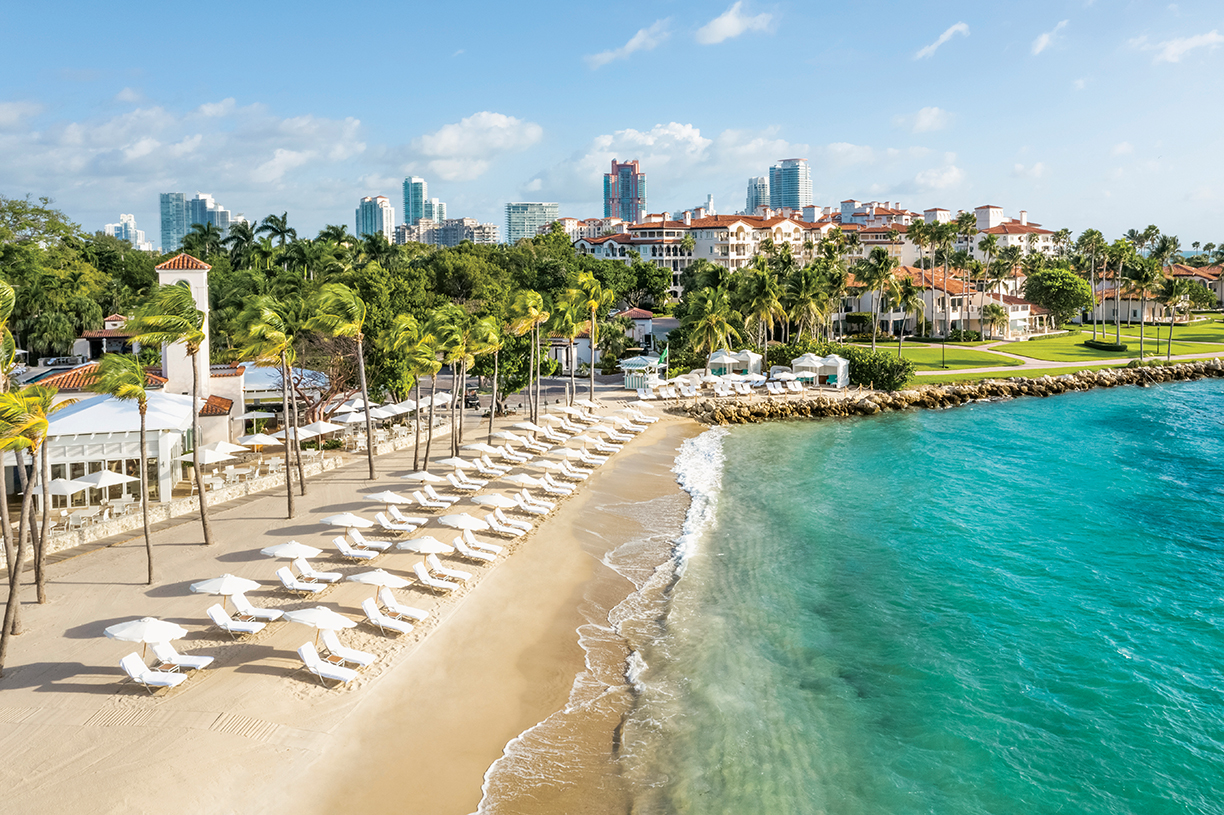
Photo courtesy of Fisherland Club
Fisher Island Club
Florida is a kaleidoscope of iconic images, from signature white-sand beaches and championship golf to Miami’s seductive skyline or theme parks encompassing much more than simply a Magic Kingdom. The entire world convenes on this alluring peninsula for every imaginable recreational experience, and its elite residents enjoy unparalleled luxury.
Florida cannot be defined by a single place or attitude, as its communities represent an incredible spectrum of physical and cultural diversity. Some feel a bit like Savannah or Biloxi, others more spiritually akin to Havana, San Juan or Brooklyn with traditions, music and aromas to match the accents. The fourth-generation Pensacola fisherman and the South Beach fashion designer who recently emigrated from Brazil contribute equally to the state’s personality.
Beachfront
With its 1,350 miles of coastline, luxury residential and hospitality developers find Florida irresistible. South Florida, where the Atlantic Coast is almost continuously developed from Miami to Palm Beach, receives the most attention, but beautiful beaches are also found in less congested areas.
Ideal for catching rays are Clearwater Beach outside Tampa and Atlantic Beach near Jacksonville, both offering wide expanses of white sand. The Space Coast’s Cocoa Beach is favored by surfers, while the dune-swept beaches of Amelia Island attract bird-watchers. The Ritz-Carlton Amelia Island is preferred by amateur ornithologists seeking maximum comfort.
Florida’s Panhandle, whose oceanfront is appropriately referred to as the Emerald Coast, features uncrowded beaches with sugar-white sand. “Distinctly more Southern than South Beach, the area is a throwback to the uncluttered and carefree beach lifestyle of years past,” reports David Merryman, manager of a premier boutique hotel called The Pearl, whose Rosemary Beach locale is reminiscent of New Orleans’ French Quarter.
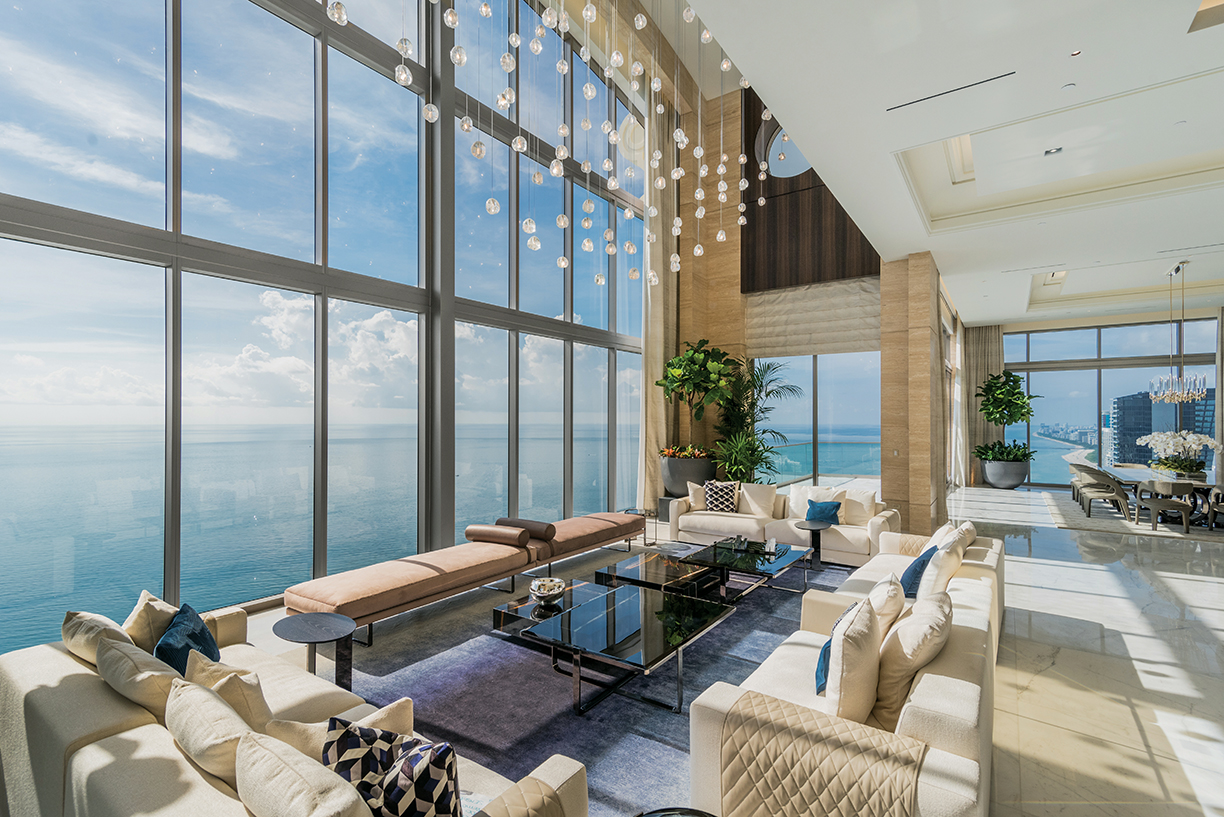
Photo courtesy of Venjhamin Reyes
The Penthouse at The Mansions at Acqualina
Tee Time
It is impossible to overstate the significance of golf to Floridian culture and economics. The game is almost a religion here, despite competition from major league and high-profile university teams, not to mention watersports. Golf generates $11 billion annually to Florida’s economy, a figure surpassing the state’s portfolio of theme parks. With approximately 1,250 courses, Florida offers more opportunities for duffers than any other state, while touring professionals are attracted to the climate, amenities and absence of state income tax.
Based in Palm Beach Gardens, PGA legend Jack Nicklaus is nearly as dominant in golf course design and development as he was on the links at the height of his career. The Golden Bear has designed courses throughout Florida, including King & Bear in St. Augustine, a collaboration with the late Arnold Palmer. The Bear’s Club in Jupiter features a 40,000-square-foot Tuscan-style clubhouse and $10 million estates line its fairways. In Naples, Nicklaus rival Greg Norman authored two courses at Tiburón Golf Club, paired with a Ritz-Carlton hotel.
Luxury homeowners on the barrier islands — they trace Florida’s Atlantic Coast like a string of pearls — enjoy access to both championship golf and the water. Because it occupies a small island, the homes surrounding South Florida’s Indian Creek Country Club are both waterfront and golf course-adjacent, resulting in prices pushing $30 million. Less pricey is the real estate bordering Juno Beach’s Seminole Golf Club, but its membership is so exclusive it reportedly once turned down Nicklaus himself.
State of Design
While influences are imported from other regions, Florida has developed its own signature style, most conspicuous in its architecture. The charismatic skyline of Miami first gained attention during the opening credits of the iconic 1980s series Miami Vice, and things have only accelerated since.
With flashy postmodern buildings and pastel-hued Art Deco jewels, Miami makes other American cities look gray and unimaginative. Celebrity architects from around the world — Norman Foster, Frank Gehry and Zaha Hadid, to name a few — have contributed to the metro area’s skyline, which some experts consider the greatest design laboratory in the world.
Much of Miami’s world-class architecture is driven by a competitive luxury real estate market in which developers use design to sell condos at a premium. In addition to those “starchitects,” residential towers are emblazoned with luxury brands — Aston Martin and Porsche from the automotive world, Armani and Fendi from the fashion world — to increase cachet value. Then-chairman/CEO Pietro Beccari stated at the project launch, “It fully expresses the codes, history and savoir faire that characterize Fendi.”
Further honoring that creative spirit is the 18-block Miami Design District that combines luxury home furnishings (e.g. Bulthaup, Poltrona Frau) with legendary fashion labels Cartier, Versace and Hermès, as well as chic restaurants and the Institute of Contemporary Art’s sleek new digs. The Gulf Coast city of St. Petersburg has created multiple districts to promote local artists and artisans.
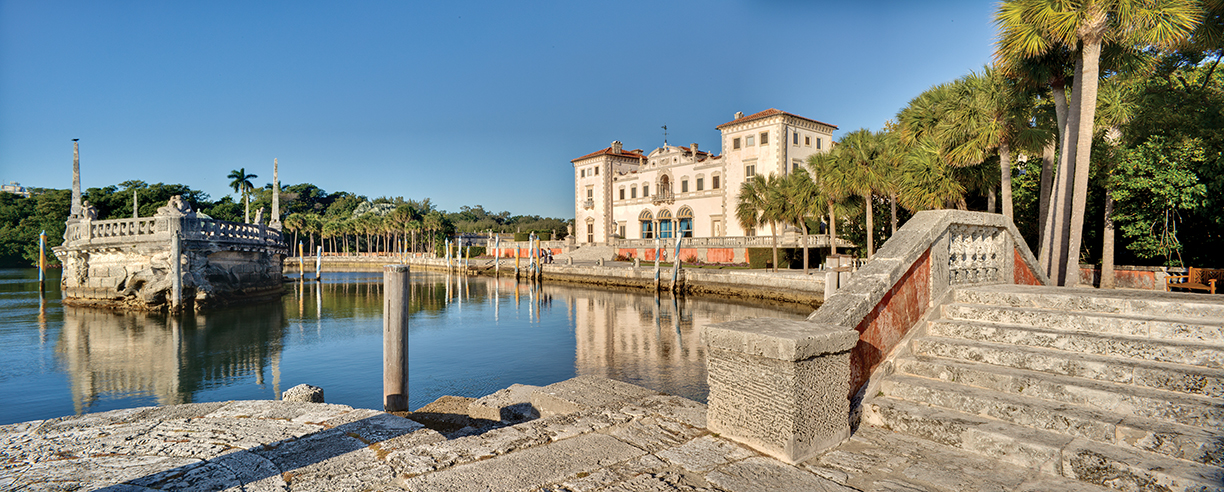
Photo courtesy of Bill Sumner
Vizcaya Museum & Gardens on Biscayne Bay
Extended Stay
Demand for luxury accommodations has fueled massive investments by premier hospitality brands, including a dozen-plus Ritz-Carlton properties throughout Florida. The Fontainebleau, an iconic landmark in Miami Beach since its debut in 1954, has been reimagined as a trendy, Vegas-style property for a new generation. More laid-back is Little Palm Island Resort & Spa on Little Torch Key, which will soon reopen after Hurricane Irma shuttered it for two-and-a-half years. Pat Colee, founding owner of Noble House Hotels & Resorts, states, “This restoration has been a true labor of love and we believe we’ve maintained the authentic character of Little Palm while ushering in added amenities.”
Historic and stately are The Breakers in Palm Beach, a perennial high society retreat, and Miami’s Fisher Island Club Hotel & Resort, a former Vanderbilt estate located in America’s wealthiest ZIP code, a seven-minute ferry ride from the mainland. CEO Bernard Lackner says of the intimate hotel with private club privileges,
“One of the few true private island sanctuaries, Fisher Island offers a lifestyle rich in leisure and recreational activities, yet just minutes from Miami’s world-class commercial, cultural and culinary offerings.”
In Florida, luxury hospitality companies have experimented with their branding of condominiums, an increasingly popular trend. Fort Lauderdale, once famous for spring break, is the site of a glitzy Four Seasons Private Residences where a 3,965-square-foot unit commands $8.9 million. “Four Seasons Fort Lauderdale has captivated buyers with its beautiful, high-class design and comprehensive lifestyle experience in the yachting capital of the world,” states Nadim Ashi, founder of project developer Fort Partners.
The Acqualina Resort & Spa in Sunny Isles Beach, one of Greater Miami’s most exclusive hotels, offers luxury residences at the Mansions at Acqualina. A $38 million penthouse in that tower includes both a Rolls-Royce and Lamborghini.
Arts & Culture
Most surf-and-sun destinations lack robust art scenes, but Florida’s cultural calendar attracts talent from around the globe. Even laid-back locales offer engaging opportunities such as Coral Springs Museum of Art near Pompano Beach, Dalí Museum in St. Petersburg and the Ernest Hemingway House in Key West. “Culture Builds Florida” is a statewide arts campaign designed to promote these assets.
Art Basel is one of the world’s most prestigious art shows (and celebrity scenes), earning Miami the international stature usually reserved for much larger cities. Year-round, Miami offers the Pérez Art Museum Miami (PAMM) and the stunning Vizcaya Museum & Gardens on Biscayne Bay while performing arts enthusiasts gather at the César Pelli-designed Adrienne Arsht Center or Gehry-designed New World Center.
Tampa’s Straz Center — it is the largest performing arts venue in the state — has been a catalyst for downtown development. “The slogan ‘Culture Builds Florida’ is true and true for us in the Tampa Bay area as well,” reports Judith Lisi, president & CEO of the Straz Center. “The arts renaissance throughout Florida reflects a statewide sense of wanting more authentic, more alive experiences in local communities,” she says.
Photo courtesy of Bazaar Photo © 2013 Ryan Forbes
The Bazaar on South Beach
Culinary Clout
With multiple cultures converging in a resort setting, it should be no surprise that the state’s culinary scene is diverse and imaginative. Pioneering chef/activist José Andrés draws inspiration from many sources at The Bazaar South Beach, incorporating foie gras into an elegant riff on Cuban coffee or winking at the Big Apple with a sophisticated, artfully presented interpretation of bagels and lox.
“Another day, another country,” is how Anthony Bourdain once described Miami, citing flavors from Africa, across the Caribbean and throughout Latin America. Florida is a Southern state, so a satisfying bowl of shrimp and grits is never far away, and regardless of cuisine, chefs proudly showcase the bounty of Florida’s farmers, ranchers and fishermen.
The food hall craze has arrived in Florida, with Heights Public Market occupying a former streetcar facility in Tampa and the 50,000-square-foot Central Fare part of a six-block development in Miami incorporating a hub for high-speed Virgin Trains. Those trains are intended to make it easier for Floridians to traverse their state, akin to Europeans whisking through the French countryside on the high-speed TGV. In Orlando, a future Virgin destination, dining options include Bull & Bear, an elegant steakhouse at the Waldorf Astoria, and acclaimed Luma on Park.
Celebrity chefs like Daniel Boulud, Jean-Georges Vongerichten and Michael Mina are flocking to Florida. Joining them is New York’s Michelin-starred John Fraser, who is bringing The Loyal, his American brasserie concept, to an ambitious new development in Miami. “Esplanade at Aventura felt like the perfect fit because they’re creating an approachable upscale culinary experience that not only captures the essence of what I try to do, but also allows me to present my craft to an entirely new audience,” reports Fraser.
The Aventura Mall was already one of the premier shopping/dining destinations in Miami, and the adjoining Esplanade demonstrates the confidence its developer, Seritage Growth Properties, has in the local economy. “Esplanade’s exciting and diverse offerings will truly resonate with both the local population and the large number of international visitors in this market,” says Meghan Kruger, senior vice president of leasing for Seritage.
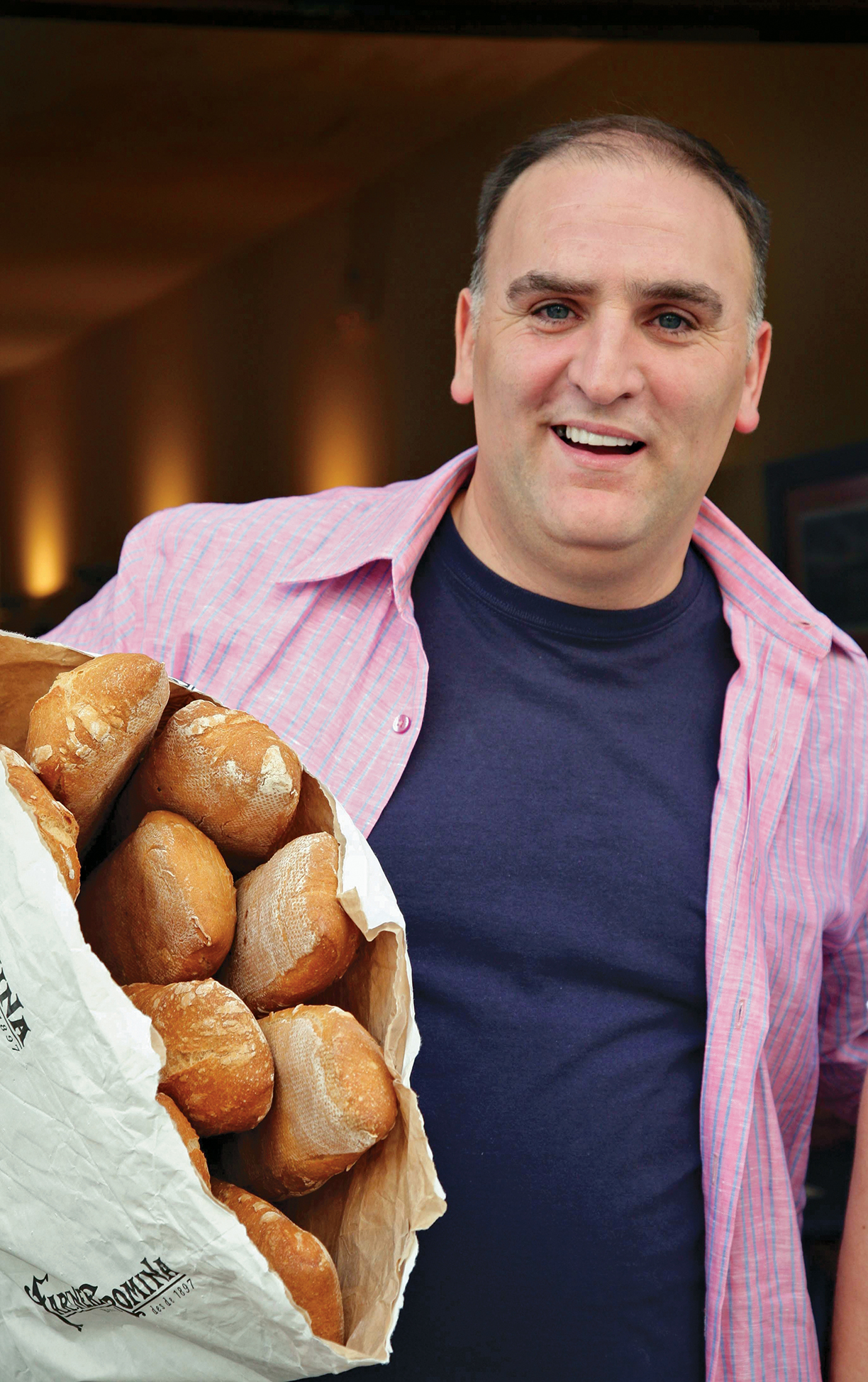
Photo courtesy of José Andrés
José Andrés
Open for Business
Florida is big business, and if the Sunshine State was a nation, its $1 trillion gross domestic product (GDP) would be eclipsed by only 16 countries. Tourism has an annual economic impact of more than $85 billion, but the Florida economy is much more diverse than manicured fairways, white-sand beaches and theme parks.
Aerospace, which arrived with the Space Program, continues to be an economic engine, with aircraft and related parts now being the state’s number one export. With long growing seasons, agriculture contributes even more to the state’s economy than tourism, and it is not just citrus (in fact, Florida’s most exported commodity is meats). Greater Orlando’s economy is no longer dominated by Mickey and Minnie, and its burgeoning technology community contributes $12.5 billion per year to its economy.
Another accelerating business sector statewide is health science, best represented by the world-class Scripps Research Institute in Palm Beach County. Florida’s growing economic influence naturally translates into greater demand for luxury amenities and residences.
This editorial originally appeared in Unique Homes Winter 2020.
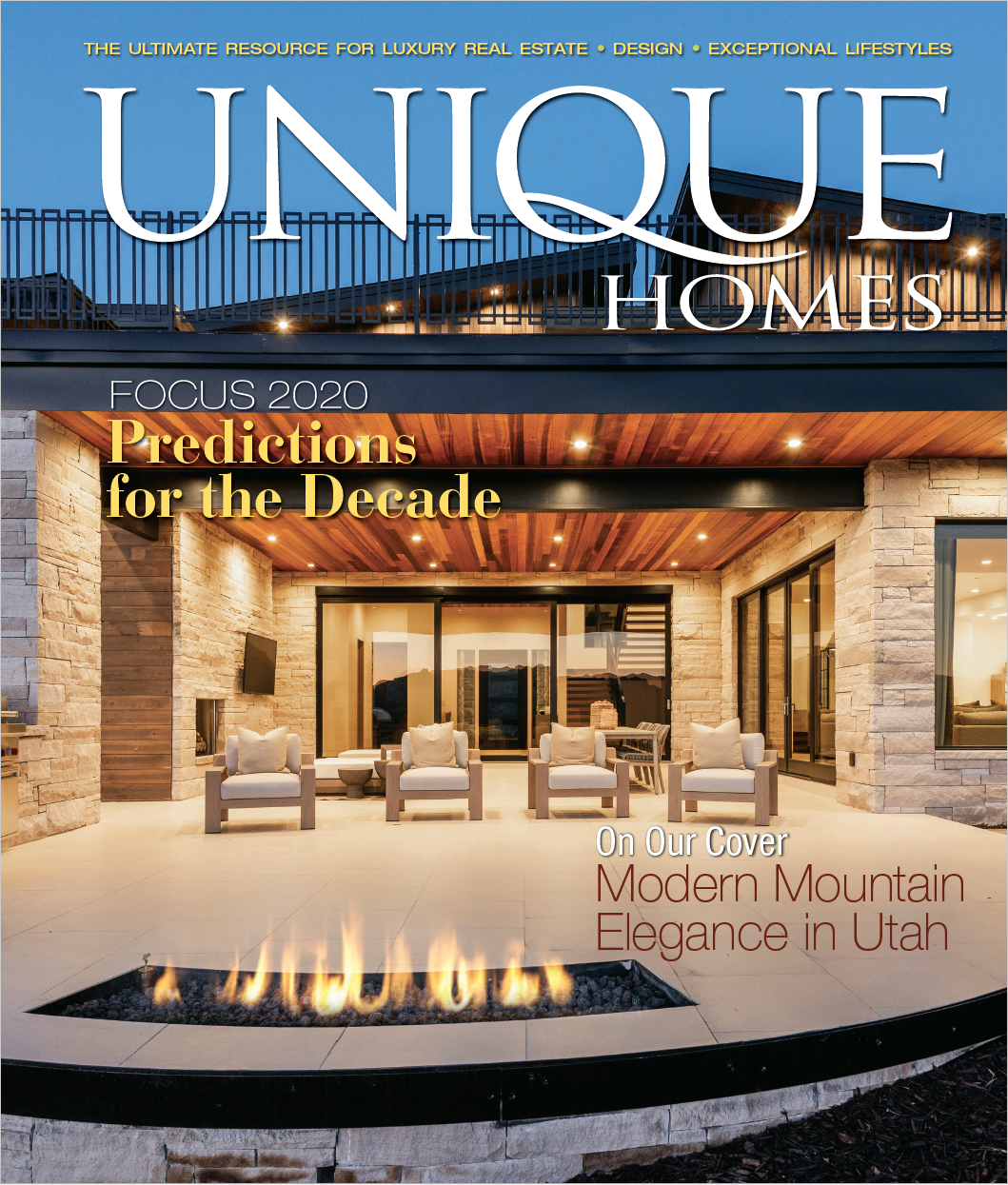

Known as the King of Pop Art, L.A.-based artist Nelson De La Nuez is one of the most sought-after pop artists working today. His work is regularly exhibited at prestigious art fairs, such as Art Basel Miami and Art Central Hong Kong, as well as promoted through partnerships and private collections, including a series of works for Warner Bros. to commemorate The Wizard of Oz’s 70th anniversary.
In an interview with De La Nuez, he discusses how the incorporation of images from American pop culture, today’s advertising, high-end branding and more have strongly influenced his artwork since the 1980s.
What kind of memories do you have from your childhood?
I was born in Havana and I came here to Southern California when I was seven years old, started first grade here. I still remember Havana, which I can remember back to when I was three years old. I took it all in. Fond memories of going to the beach, riding my bicycle around the neighborhood, doodling in the backyard.
How did your childhood affect you later on as a person, as an artist?
Well I’ve always been an artist, ever since I can remember. That kind of kept me entertained for hours, I would always get lost with [my art]. I love sports, but art has always been there for me. It was my escape. It was just a way to get away from everything.
Do you still use art to get away, now that it’s your career?
I’m always thinking 24/7 about what I am I gonna do, about ideas — so what I do is I jump on and go motorcycle riding and that kind of helps me come back again and revisit a piece or an idea, and look at something differently. What I was looking at a half hour ago looks different now, since I’m in a different state of consciousness, and I get to relax.
Material Girl
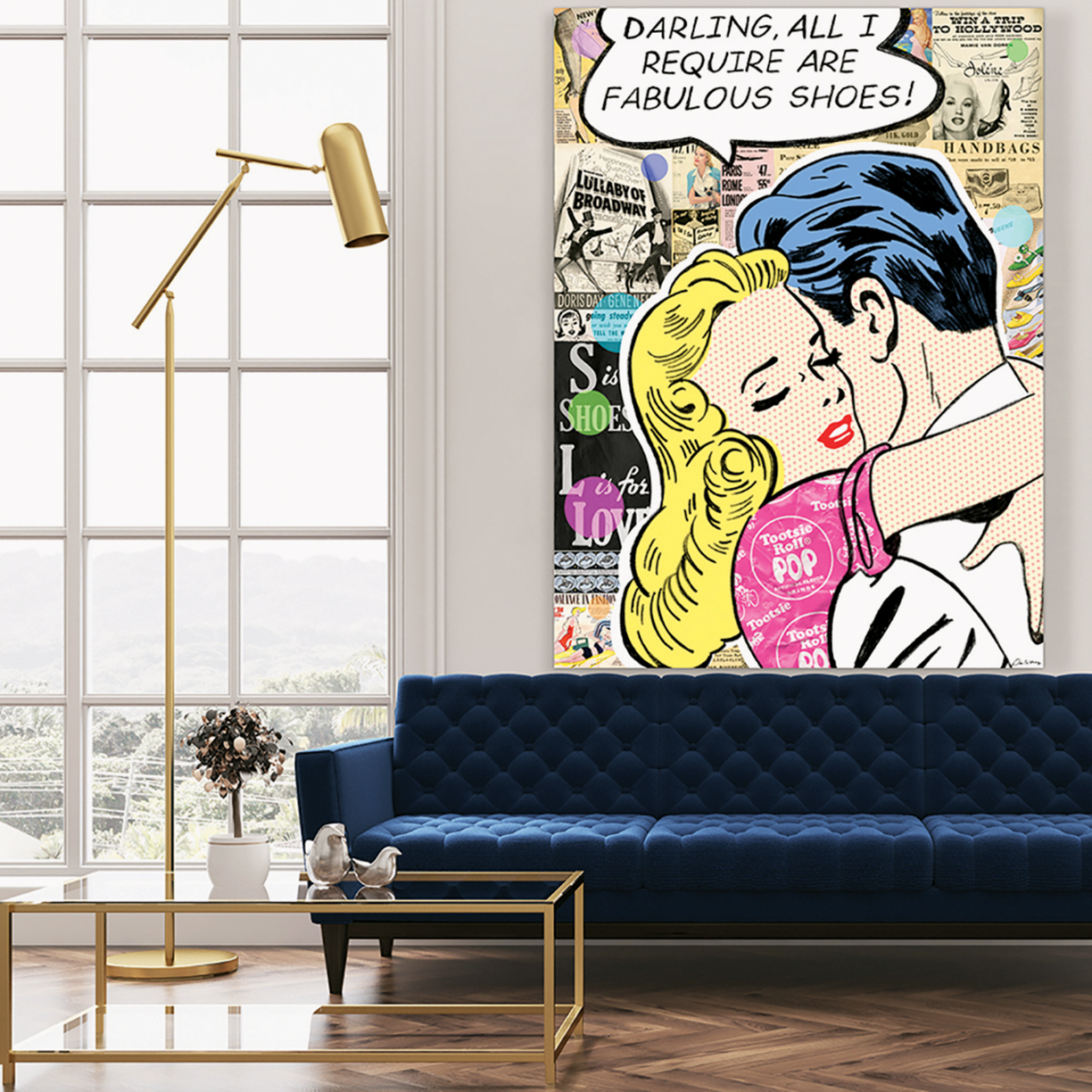
The Good Life
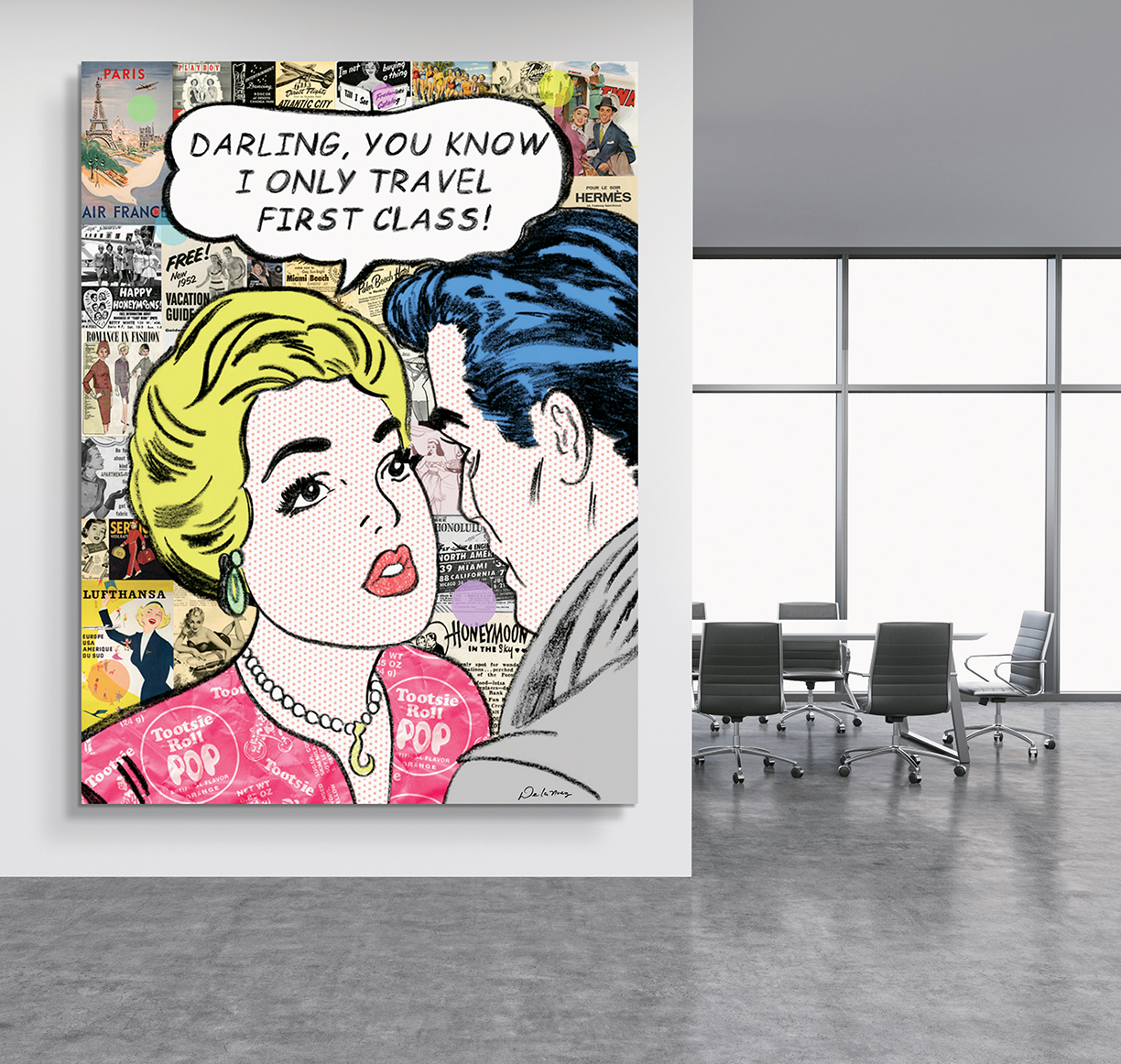
What kind of themes do you see from your childhood that are presented in your art now?
Most of what I do today is rooted in American themes from my childhood. I remember coming here [to America] and I remember seeing on TV the first Superman, TV commercials, the mascots — it all just spoke to me and I just absorbed it like a sponge.
How did these themes develop into your style?
The reason why I’m doing pop art is because of everything I observed early on when I came to this country. Living in
California is like living in a fantasy land when you come from a different country. There’s billboards, commercials, advertising, and you never know where the ideas come from. When I really think back, a lot of what I do today is really a reflection of what I was thinking and experienced when I was a kid.
Aside from your childhood, are there trends or present-day themes that inspire you?
I’m inspired by everything, literally. Every mundane object that you could think of I will look and see something there that I can maybe create into a piece of artwork. Whether it’s a billboard or a magazine ad, or an elusive train [of thought] I had the day before, I’ll ride it all the way down. I am really a byproduct of everything I’ve observed or experienced in my entire life. So I have this database in my subconscious where I can draw from.… Everything is art for me. It doesn’t necessarily need to be hanging on a wall, it could be fashion, it could be a song; everything is just an inspiration.
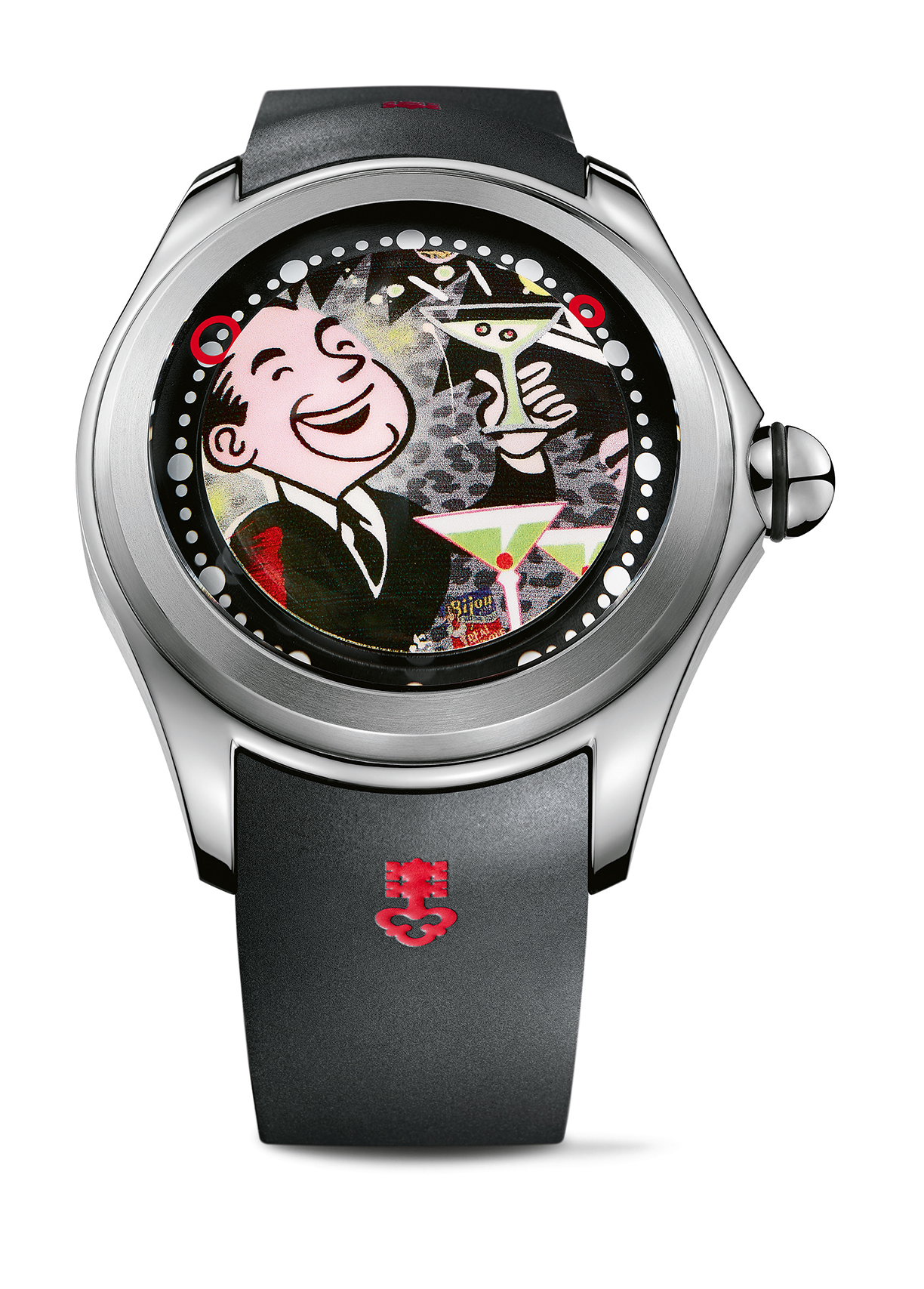
Corum Bubble Martini Watch
How does your art coincide with the clientele you usually work with?
Each partnership that I’ve done is
different, basically all with high-end brands. Each of them is unique and different; I just love working with high-end brands because it just puts my art on a different level and exposes me to a lot more people. Basically it provides a plateau to take my work to the next level and having the audience take a look at my work in a different way. That’s my audience, it’s always been a very well cultured, well traveled group that love high-end brands. It’s an audience that know what they want and how to express themselves, and they do that with my art.
What do you like most when people view your art in various forms?
I love when people react immediately. That kind of gives me a great deal of comfort. You put in all this energy and hard work and you don’t know what to expect. And they usually say “Yes, that’s the painting for me,” because it’s got legs, it speaks not just to them, but to a mass audience — it makes them happy, makes them smile, sometimes it makes them laugh. They know the perfect place that they want this for in their home. Some of them are drawn to a specific piece for no reason at all; they just relate to it.


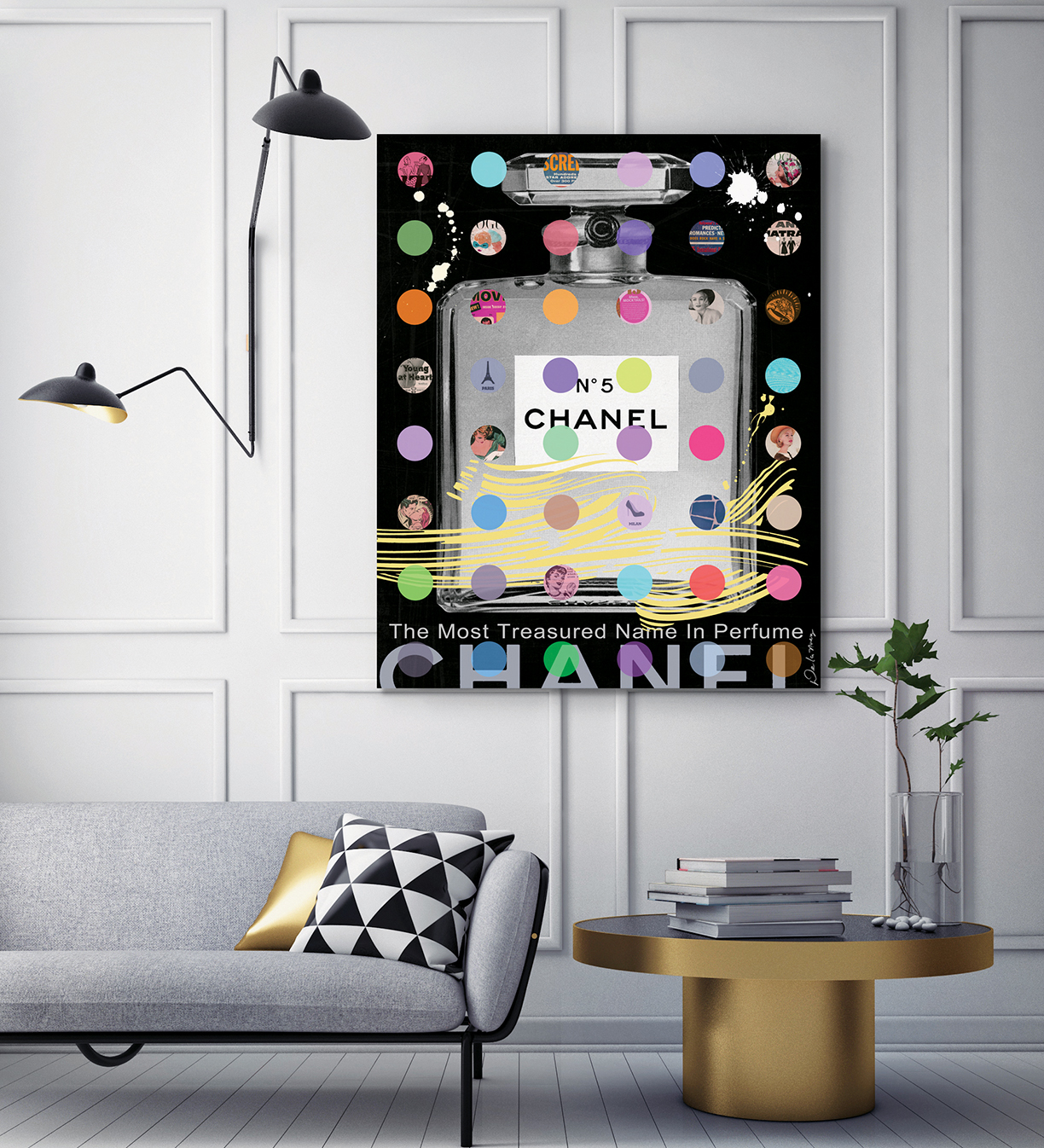
Upper Left: First Class Girl – LA Art Show 2019
Bottom Left: High Maintenance (Left) and Yacht Life (Right)
Above: Chanel No. 5 (Black)
What’s a project you’d love to work on in the future?
I would love to design something like an entire hotel design, the colors, the furniture, the wallpaper. The other thing that I would really love to do is work with a cruise ship to design their rooms, or design the entire ship using my art. That’s kind of what I get excited about most, getting to do [art] on a large massive level, where it’s not just a small project, but a huge undertaking, to take it to another level.
Any advice for aspiring artists?
The number one piece of advice I can give is that you have to be committed to your craft. You need to find out who you are and what message you want to put out into the world, then you have to be good enough and clever enough and have something unique and different. You can’t just be a part-time artist, you have to do it full time and it takes a while.… Good art is subjective, but when you have people paying sometimes hundreds of thousands of dollars for your art, you know that you’ve done something right.
In Sarasota, Florida, this home is elevating the standard of luxury, waterfront living.
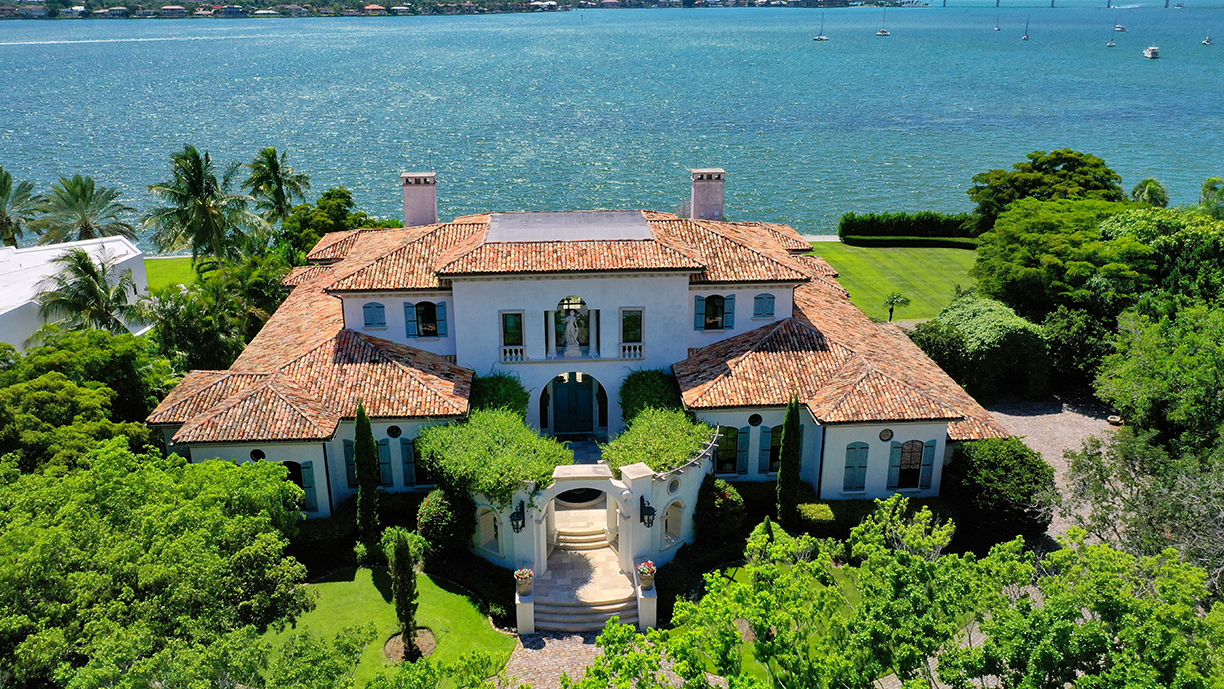
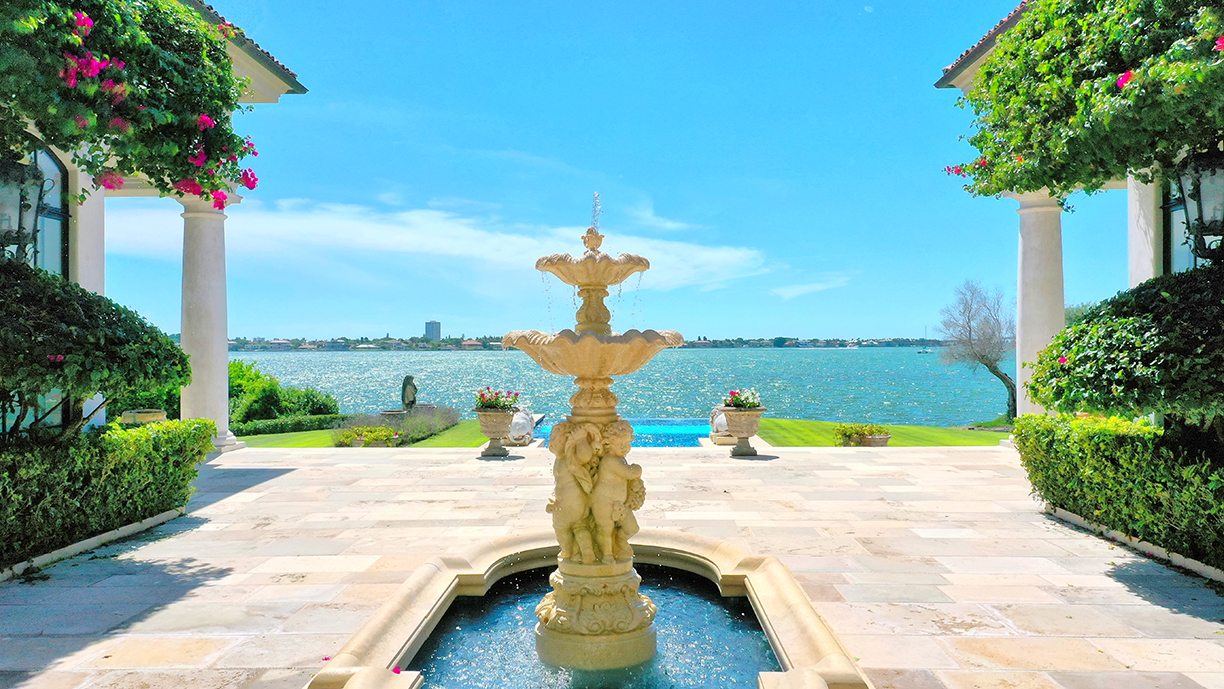
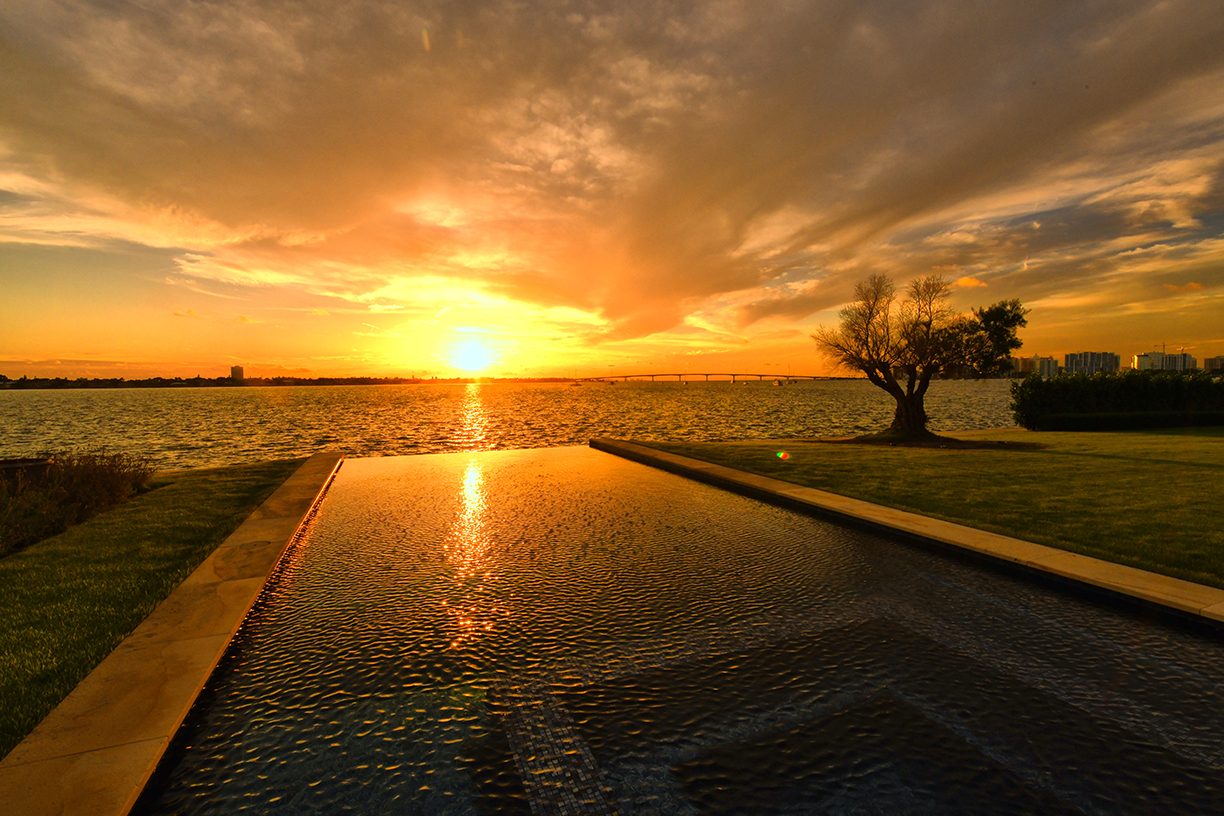
1309 Vista Drive in Sarasota, Florida, is a gated French Country private estate located right on the bay. It was built in 2015 on the 1.5-acre-plus property.
Located in one of Sarasota’s most coveted neighborhoods, Harbor Acres, the property is just as close to the bay as it is to the bustling downtown district filled with restaurants and retail stores. The perfect blend of old-world charm and modern Florida luxury.
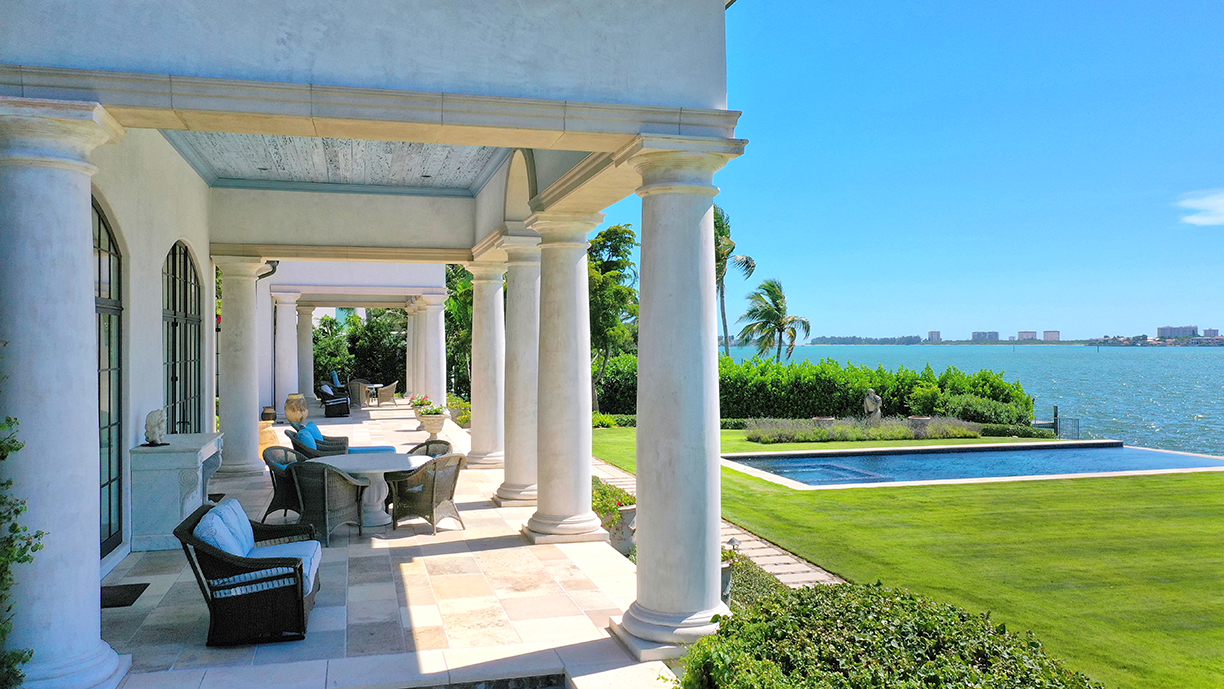
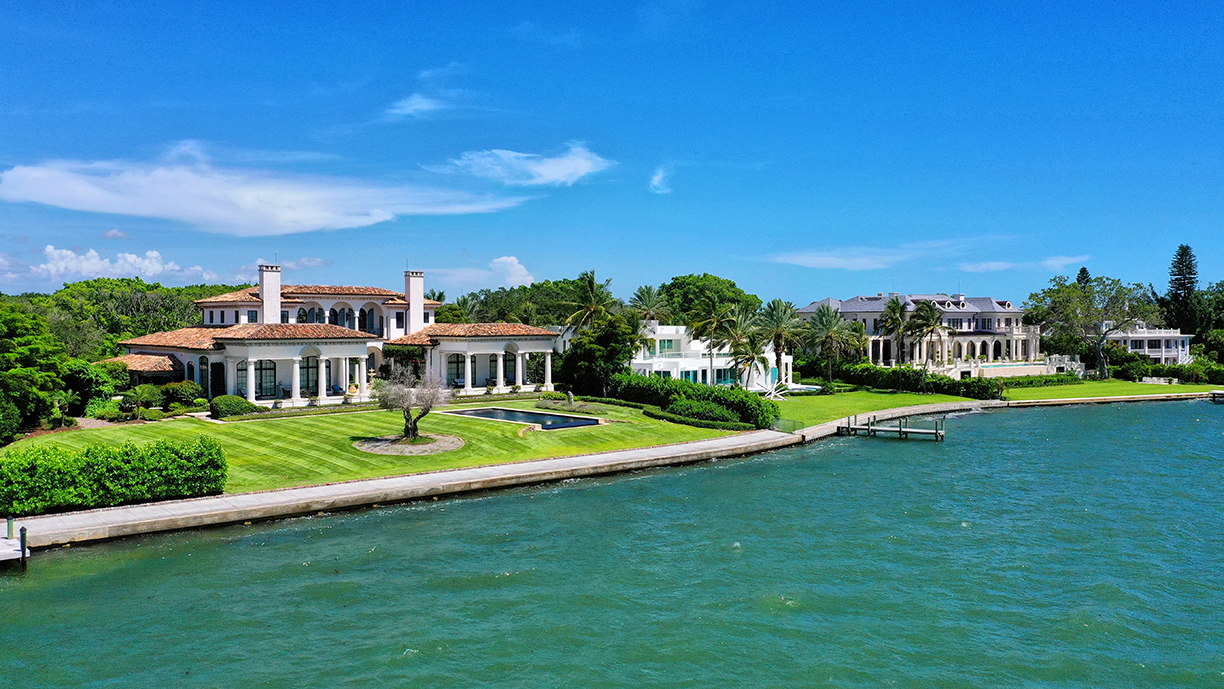
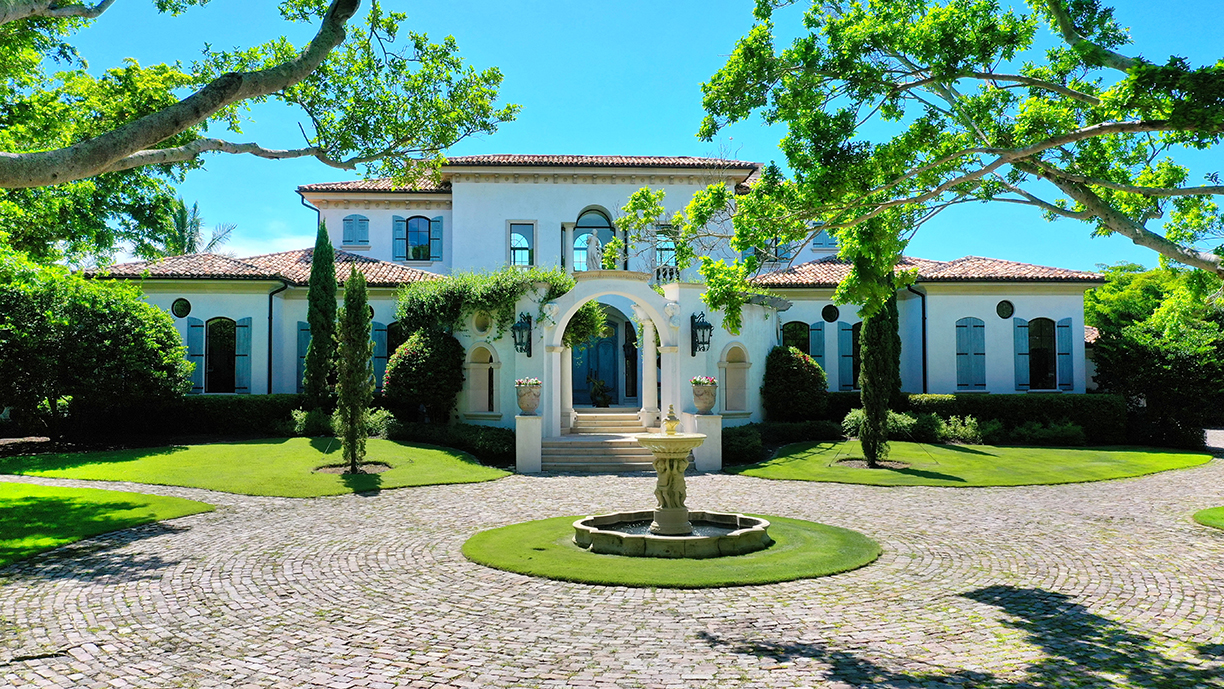
The interior of the home includes a La Cornue gourmet kitchen, imported French stone floors and cabinetry. But the quality doesn’t end inside — with over 244 feet of direct bayfront on the property, you can enjoy the water every day of the year.
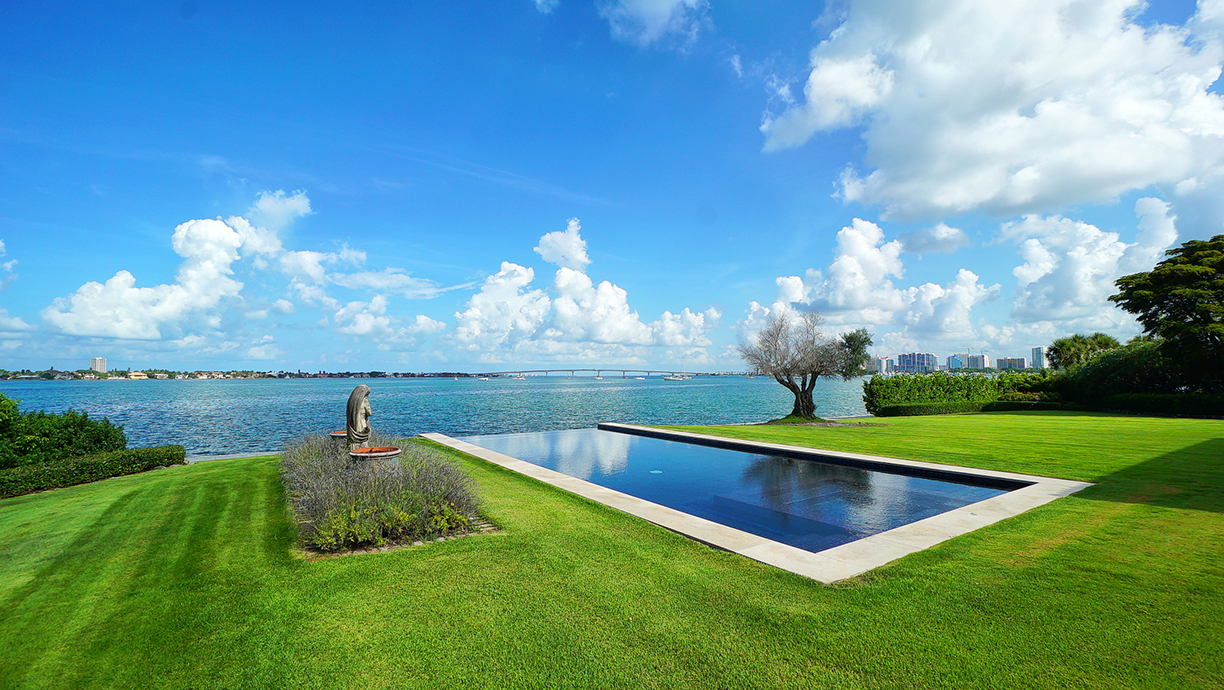
1309 Vista Drive in Harbor Acres, being a perfect blend of French charm and modern style, is the quintessential home of the neighborhood and surrounding area.
Photos courtesy of 1309 Vista Drive.
For those who love consistently warm weather throughout the year, Florida is known for its tropical, relaxed atmosphere. The palm trees and sunny days transport you to the Caribbean — especially in a residential amenity like Laguna Solé.
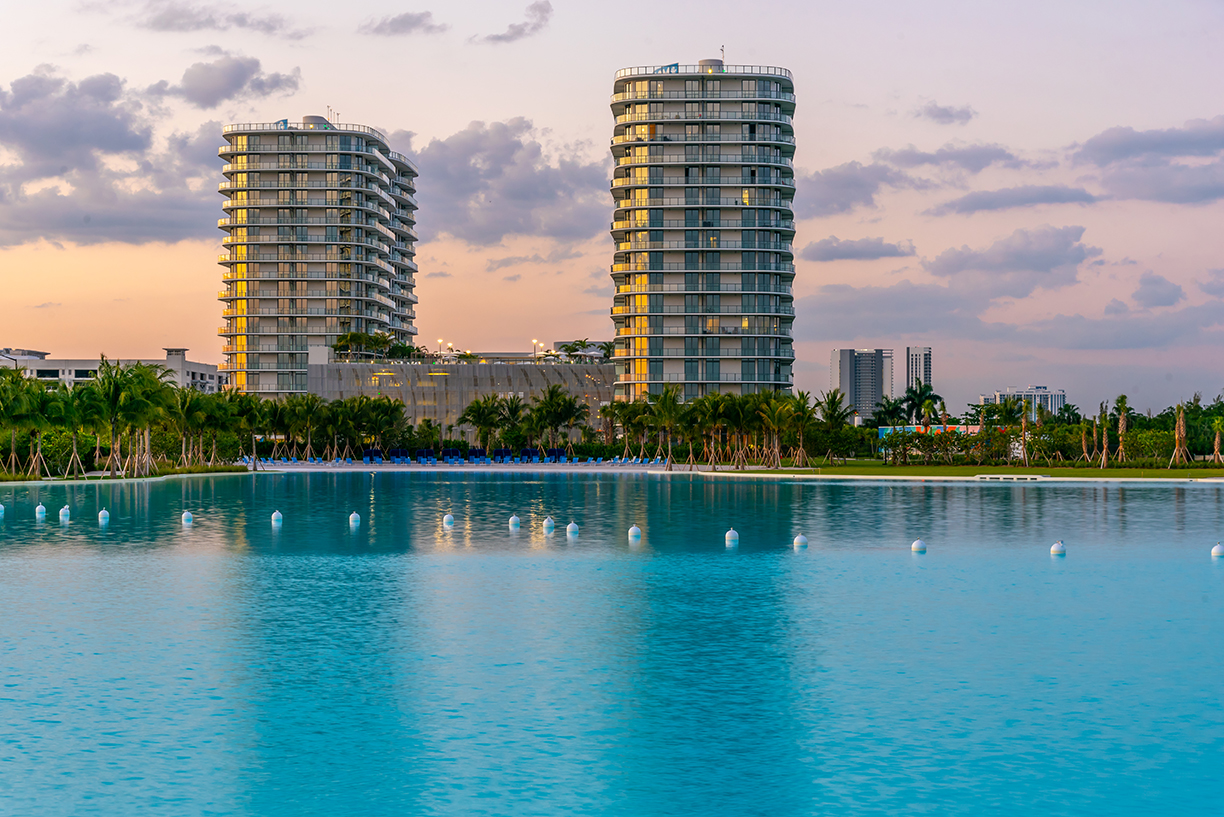
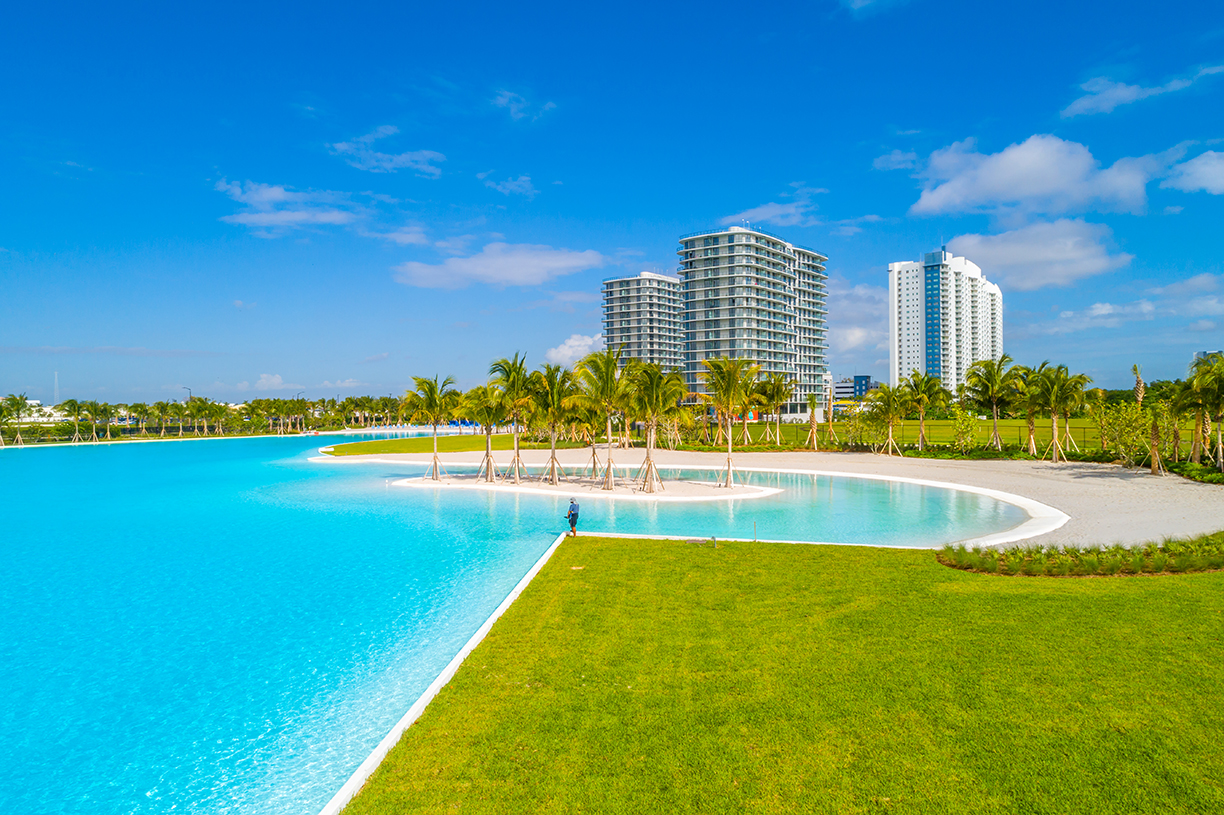
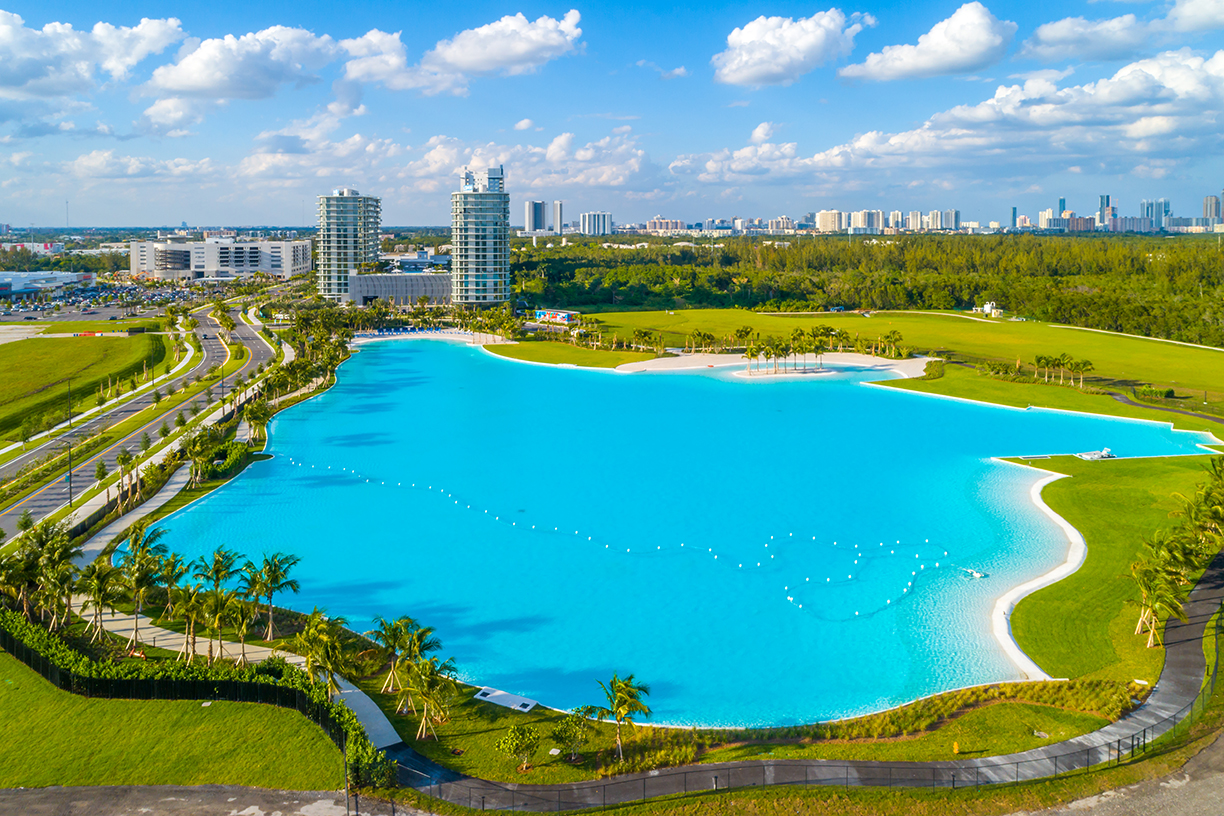
Laguna Solé is a massive 7-acre, man-made swimming lagoon large enough to fit 21 Olympic-sized swimming pools. The crystal clear water imitates the Caribbean while its ultrasonic filtration system uses 100 times fewer chemicals than a regular pool.
The lagoon is located in the heart of Solé Mia, known for being the “city within a city” that’s being built by two of the most powerful real estate dynasties in America, the LeFraks and Soffers. The LeFraks developed LeFrak City in New York and Newport, New Jersey, while the Soffers are known for developing much of what Miami is today.
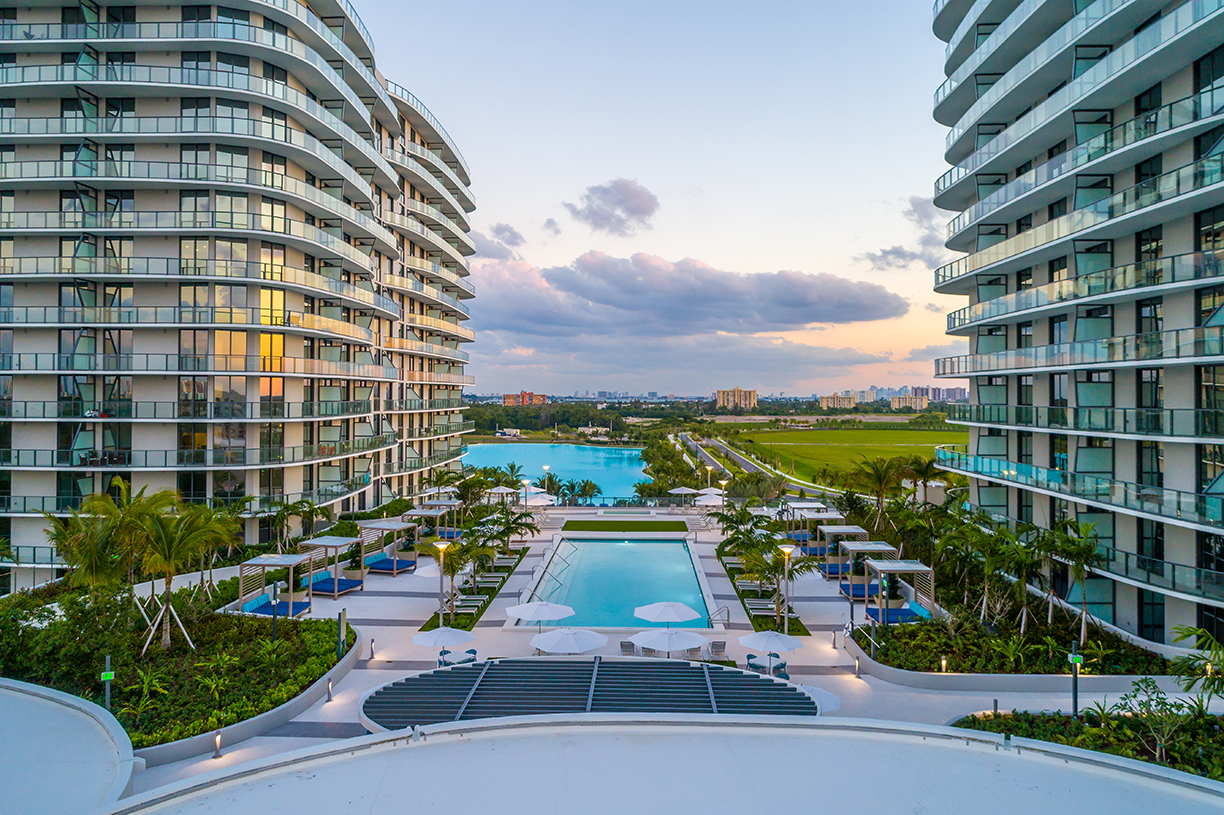
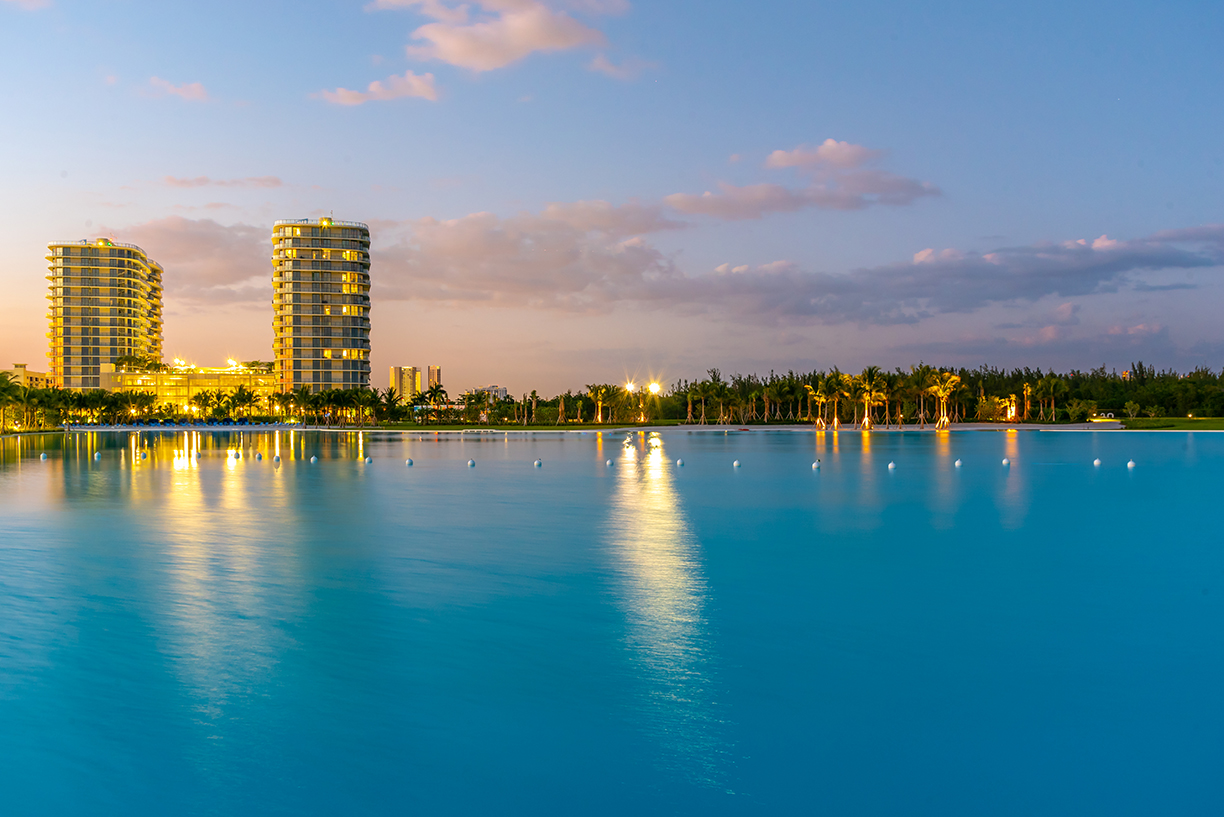
The lagoon is accessible by residents and guests of the Shoreline, Solé Mia’s newest two residential towers located right next to the lagoon.
The $4 billion city of Solé Mia is known for its residential amenities that are elevating the standard of residential living — and Laguna Solé is the most recent and extravagant example.
Photos courtesy of Solé Mia.
Inspired by the silhouette of a tulip, Turkey’s official flower, a 70-story architectural masterpiece will soon grace the Miami skyline with dynamic living and hospitality experiences within a multi-purpose tower, delivering sophistication, convenience and the finest fusion of brands.
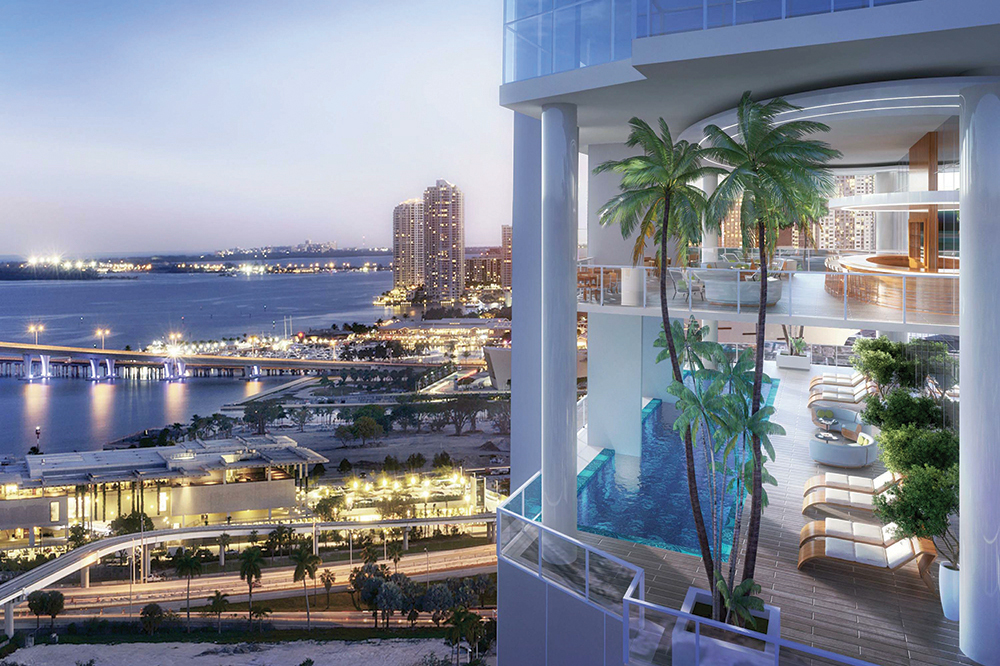
Okan Group — one of Turkey’s leading companies and a significant developer — has announced the official sales launch of its first U.S. development in Downtown Miami’s urban core: Okan Tower. Uniting a diverse collection of mixed-use elements in one vertical destination, the project will present a 316-key hotel by Hilton Hotels & Resorts, 64,000 square feet of ‘Class A’ office space, 236 additional condo-hotel units starting on the 36th floor, and 149 condominium residences, plus 4 penthouses, starting on the 51st floor.
Located at 555 North Miami Avenue, Okan Tower will bring a new, defining form to the city’s iconic horizon. Exclusive sales and marketing for the development is by ONE Sotheby’s International Realty.
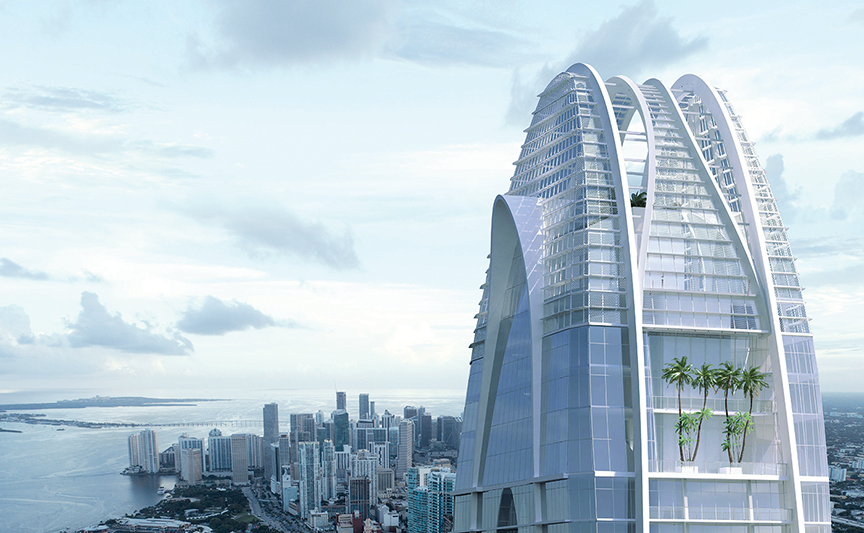
“We are thrilled to be launching sales for this much anticipated new development. The reputation and prestige synonymous with the Okan brand, paired with the company’s financial strength, communicates great confidence in the market,” says Daniel de la Vega, President of ONE Sotheby’s International Realty. “Okan Tower’s team of power players and overall vision affords this project a unique edge in Miami’s real estate landscape, and we are proud to be part of this venture.”
Billionaire businessman and Okan Group Chairman Bekir Okan greatly credits Miami’s vibrant energy and international fusion in his decision to name the city for the tower’s location. In between travels around the globe, Mr. Okan frequents his South Florida residence, which furthers his desire to allow the company’s roots to bloom in the Magic City, tied closely with the Hilton Hotels & Resorts name.
Considering the global footprints of Okan Group, Hilton Hotels & Resorts and Sotheby’s International Realty, Okan Tower’s world appeal will take its sales team across continents to showcase the product, including the U.S., Turkey, Latin America, Europe, and Asia. According to Miami Association
of Realtors’ latest South Florida International Real Estate Report, South Florida continues to strongly draw foreign buyers, who purchased $7.1 billion of area residential properties in 2017 – up from $6.2 billion the year prior – and accounted for 35 percent of closed sales.
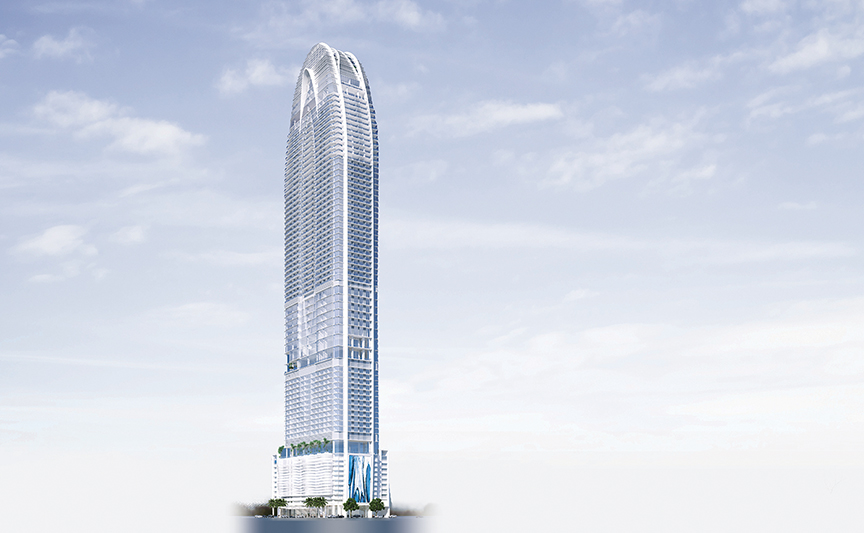
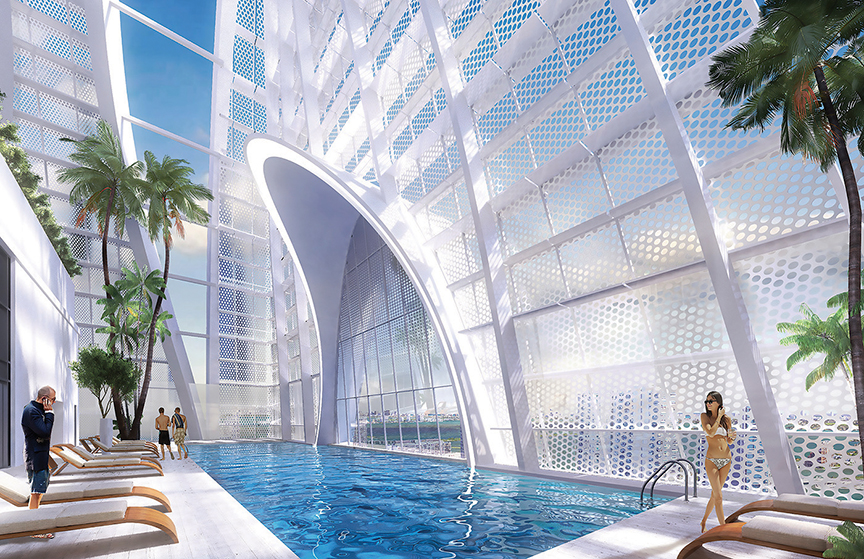
Paying tribute to the Turkish culture, architect firm Behar Font & Partners was appointed to design Okan Tower and the striking curvature of its façade. Anticipated to attract international investors, the project’s condo-hotel units will be delivered turn-key within studios, and one and two bedrooms, from 447 to 1,245 square feet. Residential offerings will include condominiums ranging from one-to-three bedrooms, plus a den, with floor plans from 698 to more than 2,071 square feet. Two floors of duplex-style penthouses will feature expansive layouts, from 1,873 to more than 2,142 square feet.
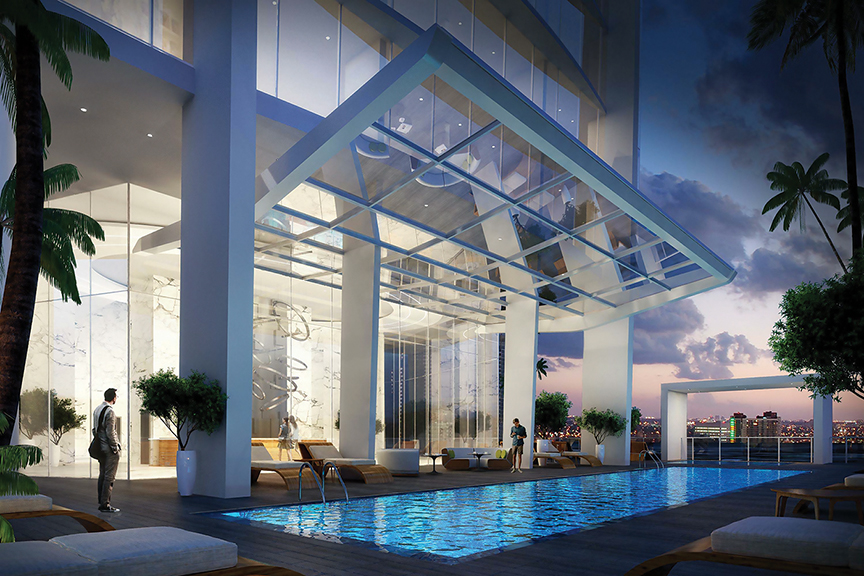
World-class amenities will not be spared, with Okan Group carefully curating a menu of offerings that truly matter to the target demographic. This includes high-speed elevators with separate access points for the various mixed-use components, a sky pool with panoramic views of the bay and city on the 70th floor, Hammam spa, state-of-the-art health and fitness center, multipurpose room, and outdoor lounge. Additional features will be a playroom for kids, chef and gastro kitchen, a resident movie theater, and private area for owners with wine cellar and cigar room, as well as an activated rooftop restaurant on the 67th floor.
Okan Group brings to Miami nearly five decades of experience and a long-established reputation in Turkey and other parts of the world. The company has expertise in a variety of industries, including construction, tourism, education, health, and hospitality.
Photos courtesy of Okan Tower.
Wynwood, recently named one of America’s hippest neighborhoods by TripAdvisor, will get its first micro-style units with the addition Wynwood 25, where, “The Sky is the Limit.” The micro-style living is a growing trend in Miami, as it is aiding the transition from just a vacation hotspot to an authentic, urban center for young professionals.
Brooklyn-based interior designer, Meshberg Group, who are lauded for giving Brooklyn much of its design identity, was pegged to design Wynwood 25’s amenities and units with a Brooklyn touch. The project will feature a garden rooftop terrace with a pool, spa, grill, indoor/outdoor co-working spaces and green areas. Other building amenities will include a fitness and yoga center, coffee lounge and outdoor courtyard, and is slated for completion in summer of 2019.
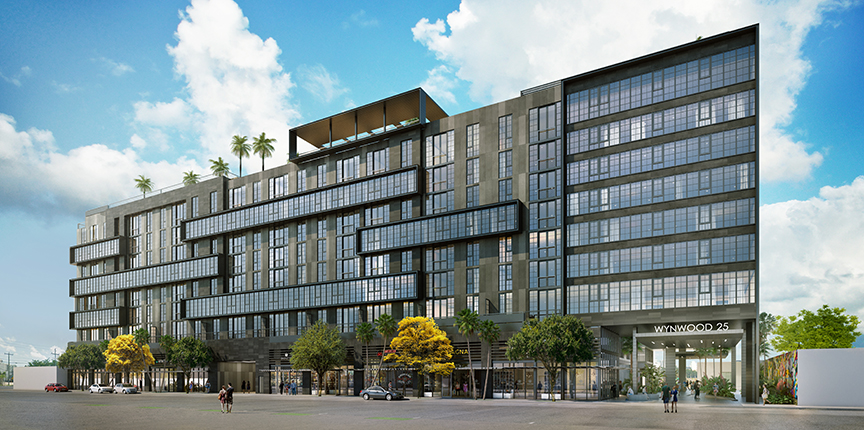
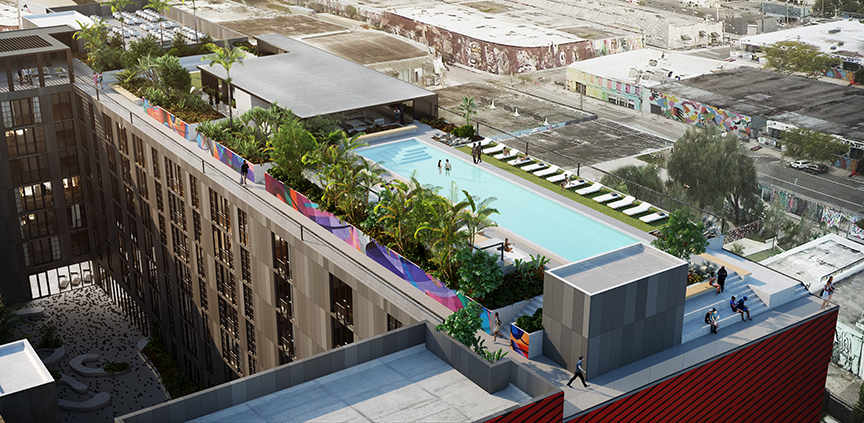
Micro-style units are becoming more and more popular in the Miami real estate market. Though Miami is currently pushing their luxury development, so much that it is now the sixth least-affordable major market in the U.S., according to a recent Demographia International Study, these micro-style units are providing another option for potential buyers. The majority of micro-unit dwellers are young professionals and first-time renters under 30, considering location the most important priority.
“The design for the micro-style units is for efficiency and a modern minimalist style, like smaller New York-style spaces, which are uncommon in the heart of Miami,” said Adam Meshberg from Meshberg Group, “For contextual visual elements, we used brick, exposed concrete and natural wood materials throughout the interior. This decision is shaped by our adaptive re-use experience in NYC where land is expensive and converting old buildings is the norm.
He continued, “Directly influenced by the latest in NYC, the programming of amenity spaces caters to the new way people live in urban areas. For instance, we created co-working indoor and outdoor spaces to encourage collaboration and comfort to work from home spaces, as well as a larger state of the art gym with on demand fitness studio,”
Wynwood 25 will be affordable and convenient, offering units ranging from 400–1,200 square feet for $1,600 to $1,750 per month. Rooms will be equipped with state-of-the-art kitchens and bathrooms, including access to the spectacular rooftop lounge, merging culture and recreation.
Renderings courtesy of Kobi Karp
Whether it’s a 48-story tower in New York City or a Mediterranean-style development in Fisher Island, Florida, these developments have been meticulously crafted to reflect early renderings.
While renderings are often closely aligned with the final project, there are often changes made to the design during construction.
With constant advances in technology, computer generated renderings have become almost indistinguishable from reality. Can you spot the differences?
From renderings to reality, these developments are pushing the boundaries of design and architecture.
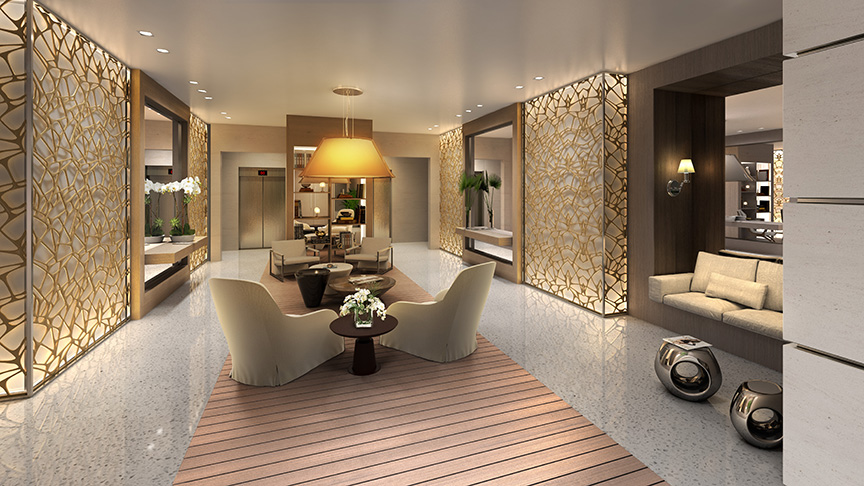
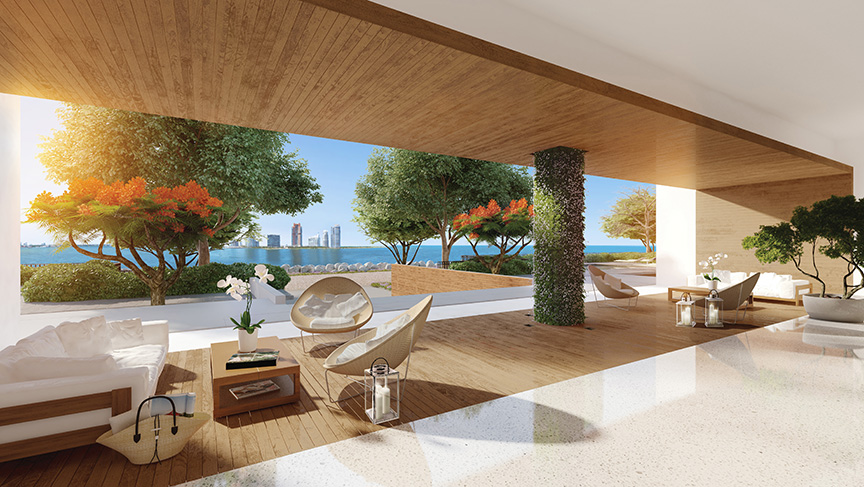
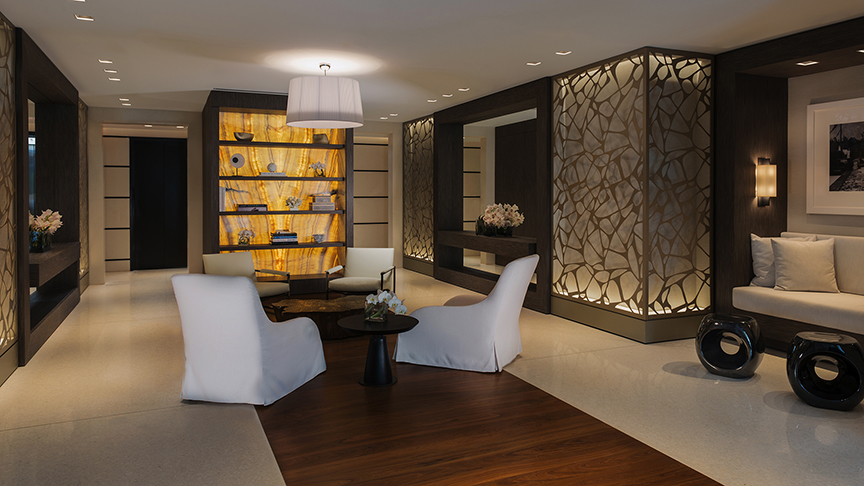
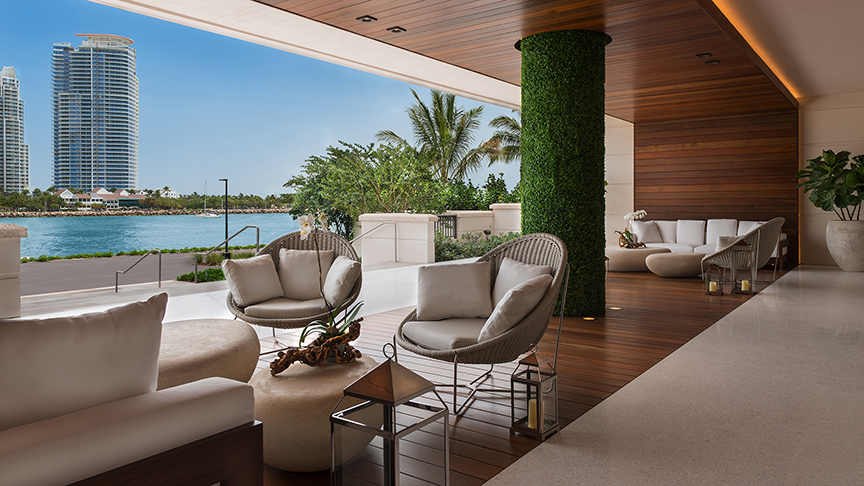
Palazzo Del Sol
American Copper
Designed by SHoP Architects to be the tallest copper-clad building in the world, The American Copper Buildings presents two bold and dynamic residential towers on New York City’s East River. The approximately 800-unit luxury rental community reaches 41 and 48 stories in height with an iconic skybridge connecting the two towers.
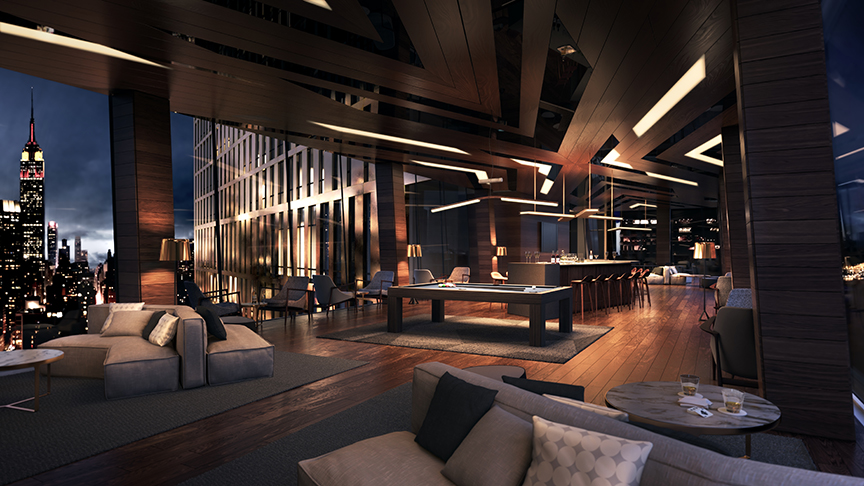
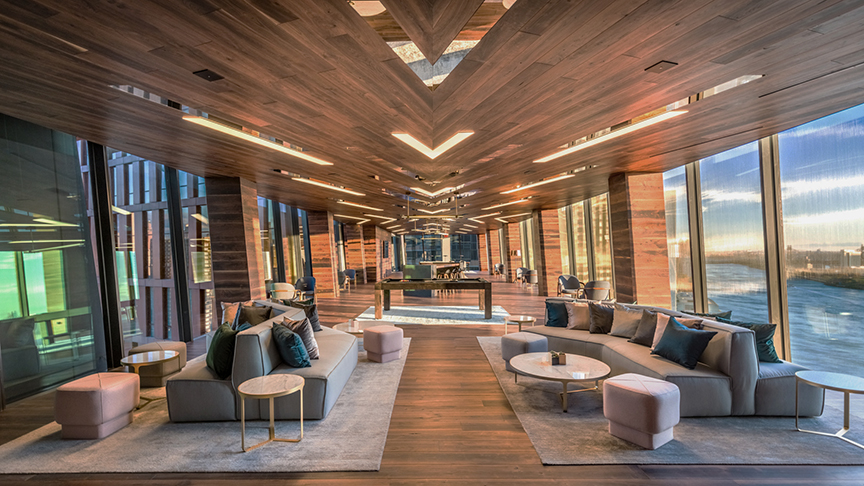
Photos by JDS Development
Palazzo Del Sol
Designed by Kobi Karp, Palazzo Del Sol’s exterior design adds to Fisher Island’s Mediterranean aesthetic while the amenity spaces and lobby, designed by Antrobus +Ramirez, draw inspiration from the elegance of old world architecture.
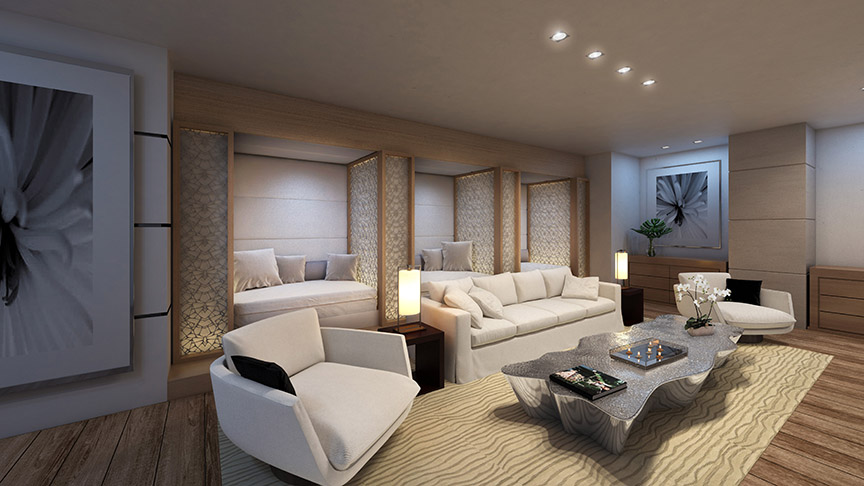
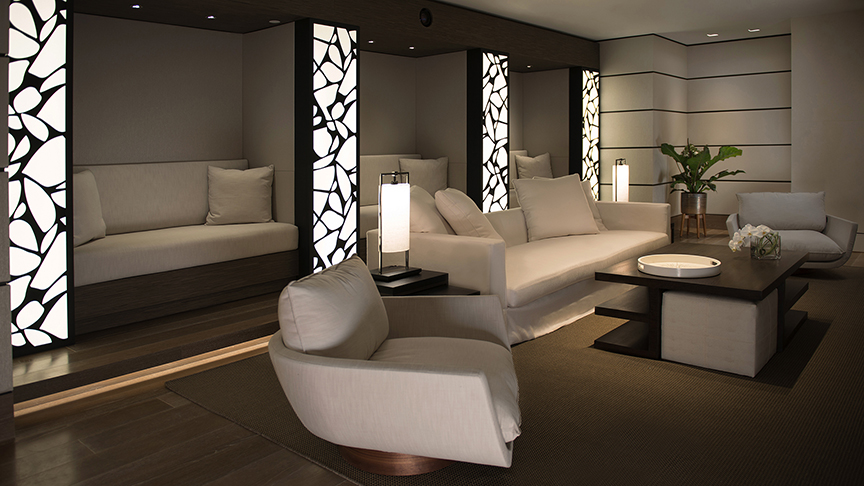
Palazzo Del Sol
Baltic
Located in the northeast corner of Baltic Street and Fourth Avenue in Park Slope, Brooklyn, this 43-unit, boutique condominium is distinguished by its quality construction and exceptional living space. Wrought in golden gray brick, the building integrates a range of beautiful stones, including marbles, granites, quartz, and labradorite, as well as woods such as walnut and oak.
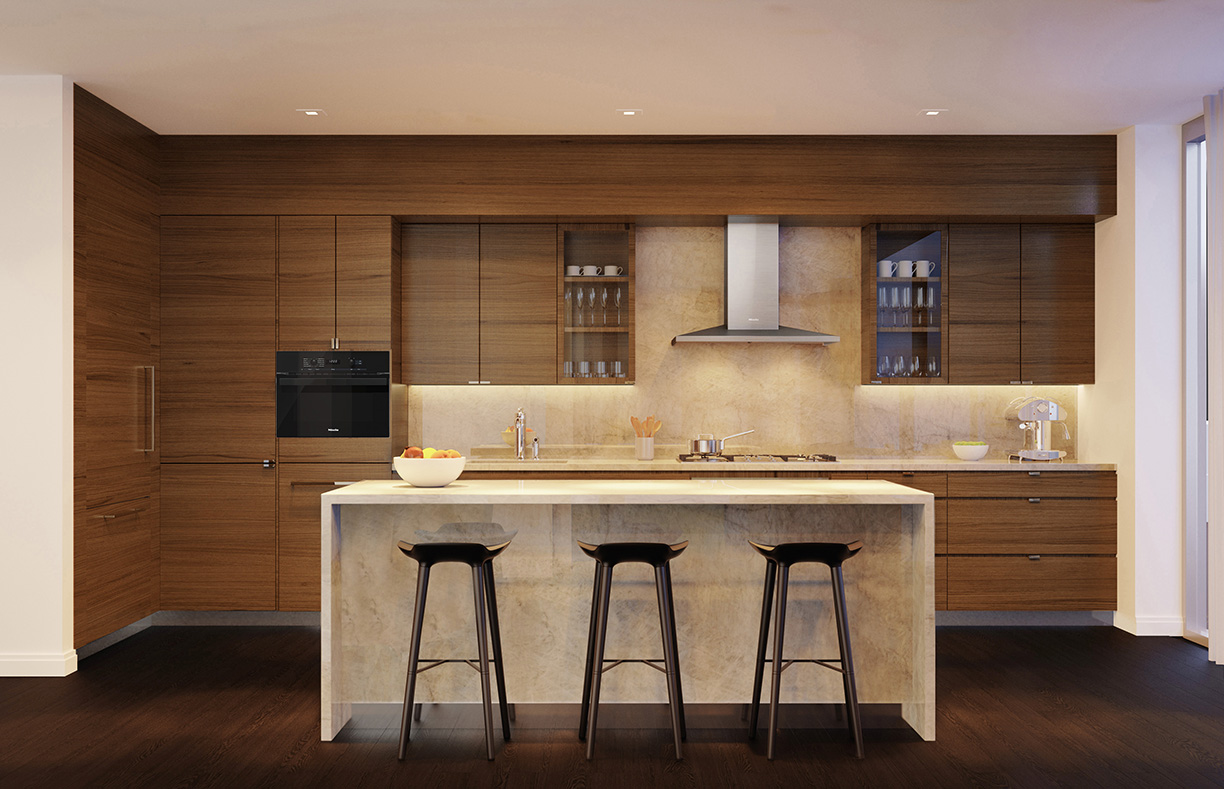
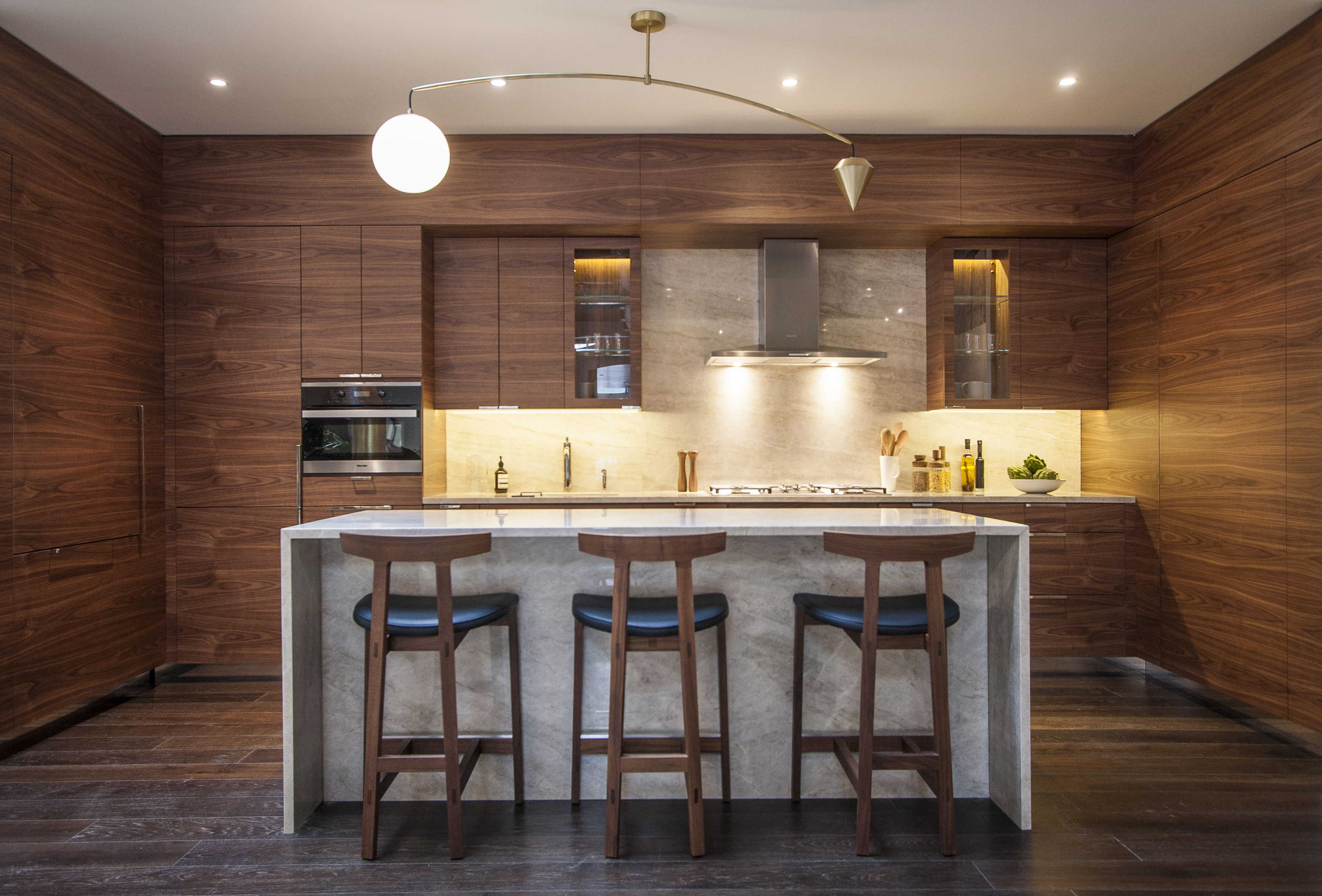
Photos by JDS Development
111 West 57
This New York City project will serve as a combination of the original landmarked Steinway building designed in 1925 by Warren & Wetmore, and a new tower designed by SHoP Architects and Studio Sofield.
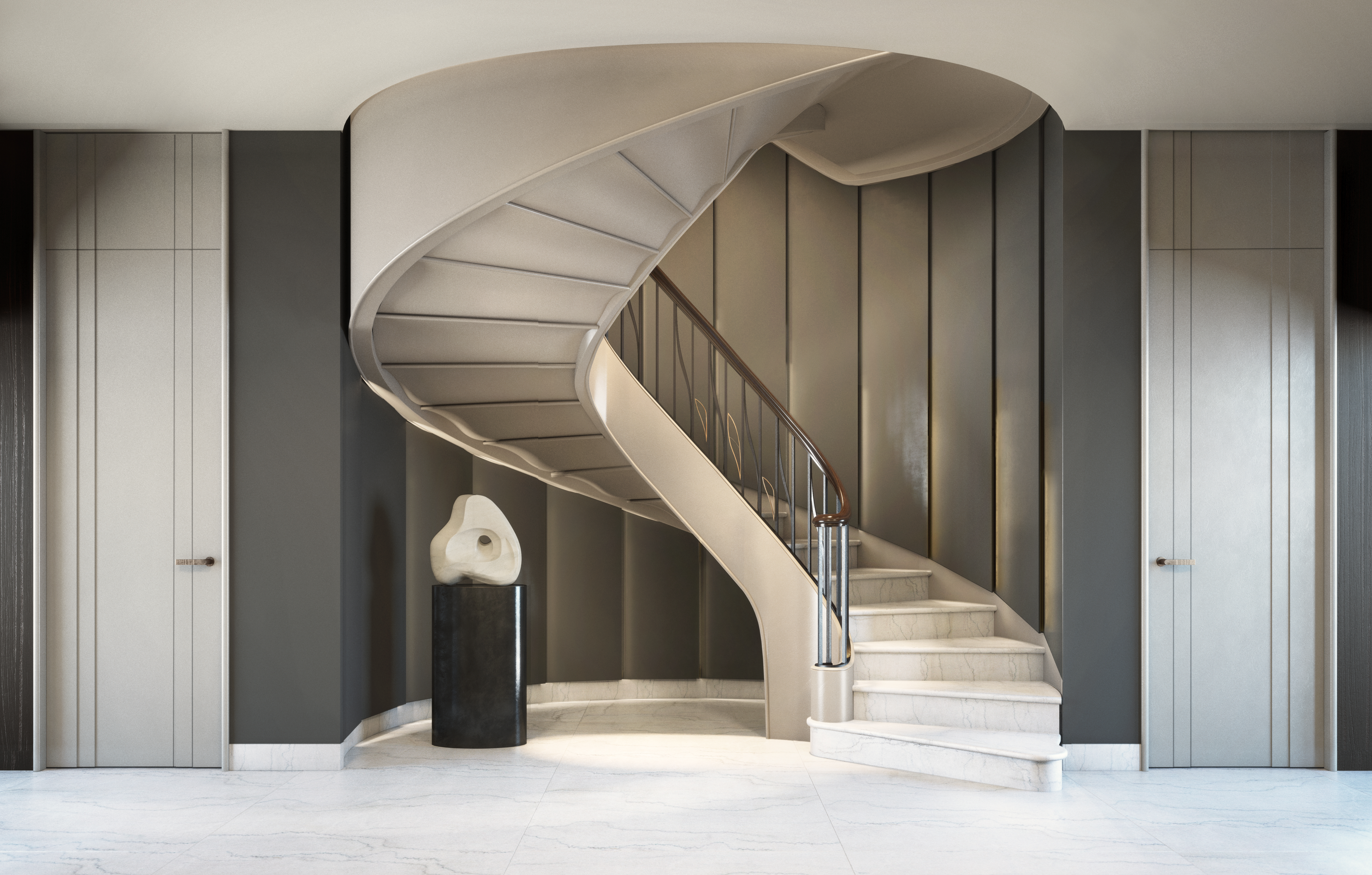
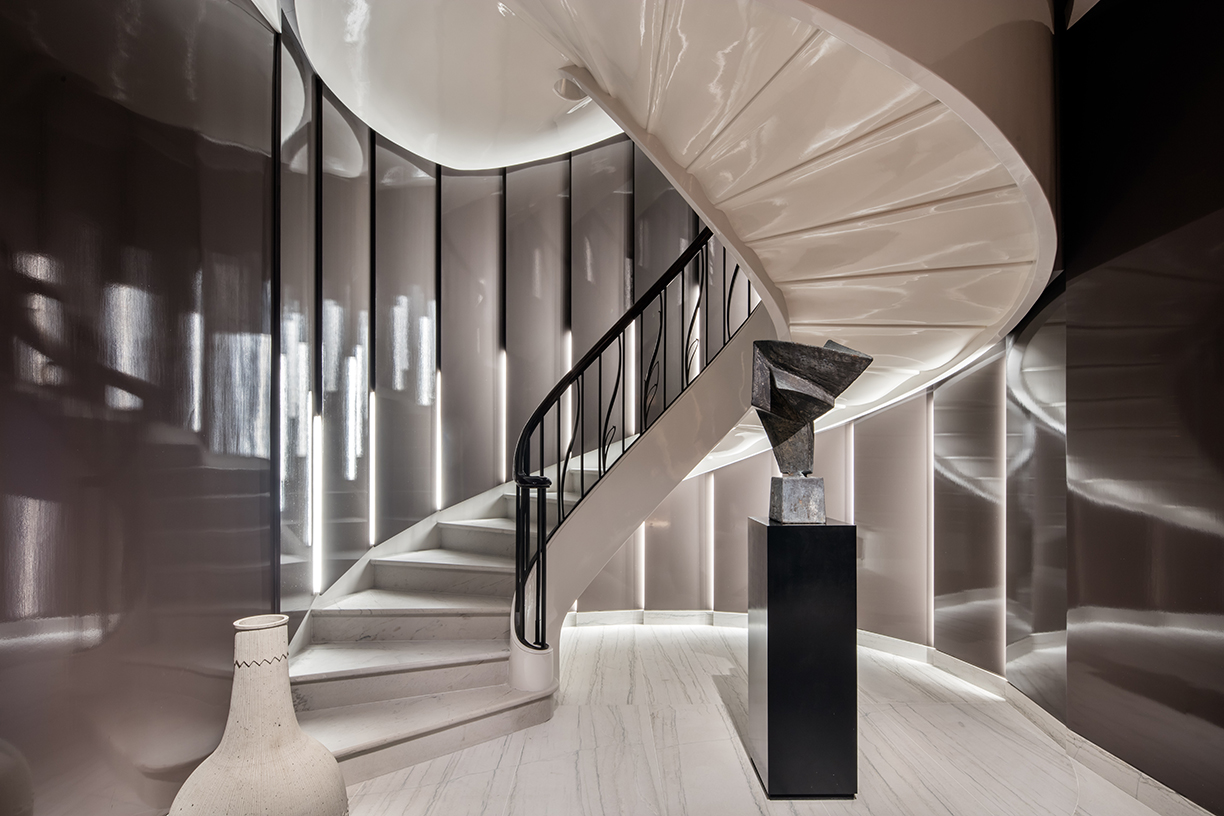
Photos by JDS Development
Photos by JDS Development
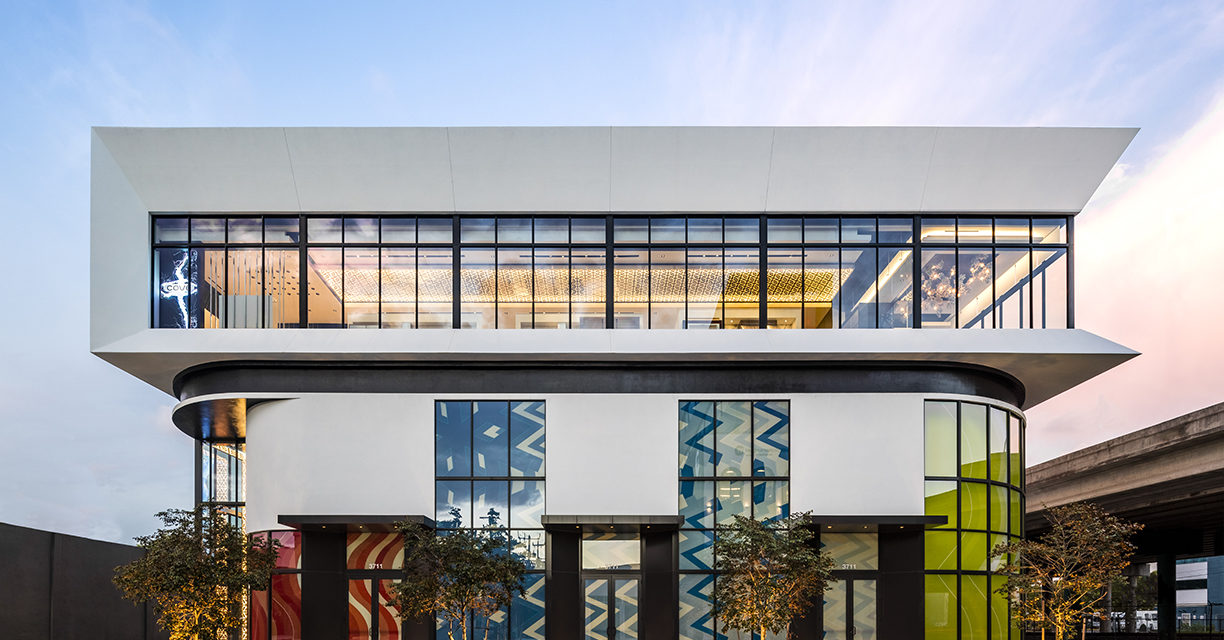
The 7,500-square-foot designer space features more than 135 premium Sub-Zero, Wolf, and Cove products and illustrates product innovation with unique culinary experiences
Now on display in the heart of the Miami Design District, Sub-Zero, Wolf, and Cove open their newest showroom, which showcases premium refrigeration, wine preservation, cooking equipment, and luxury dishwashing.
At the center of the showroom is a 780-square-foot demonstration kitchen with 20 active appliances, allowing guests to test out the products’ features and functionalities. The showroom will host an ongoing calendar of programming spearheaded by showroom manager Barbara Barnes and culinary experiences led by executive chef Alex Diaz.
The showroom’s arrival highlights the growing sophistication of the culinary scene in South Florida, providing the company with an immersive experience center to serve the Florida, Caribbean and Latin American design communities, and will welcome consumers, designers, distributors and culinary talent. The Miami showroom is one of 60 exclusive showrooms across the globe in preeminent hubs for luxury design including Manhattan, Costa Mesa, London, Hong Kong and Cannes.
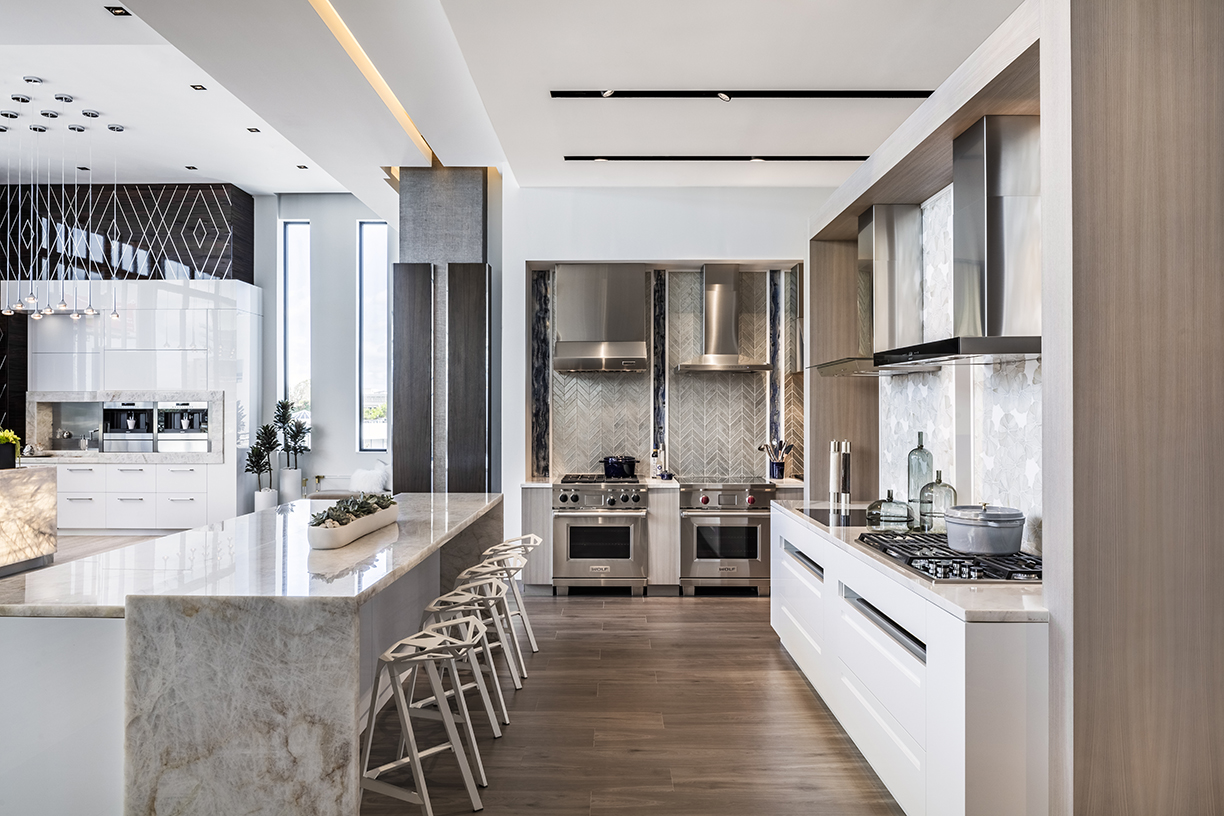
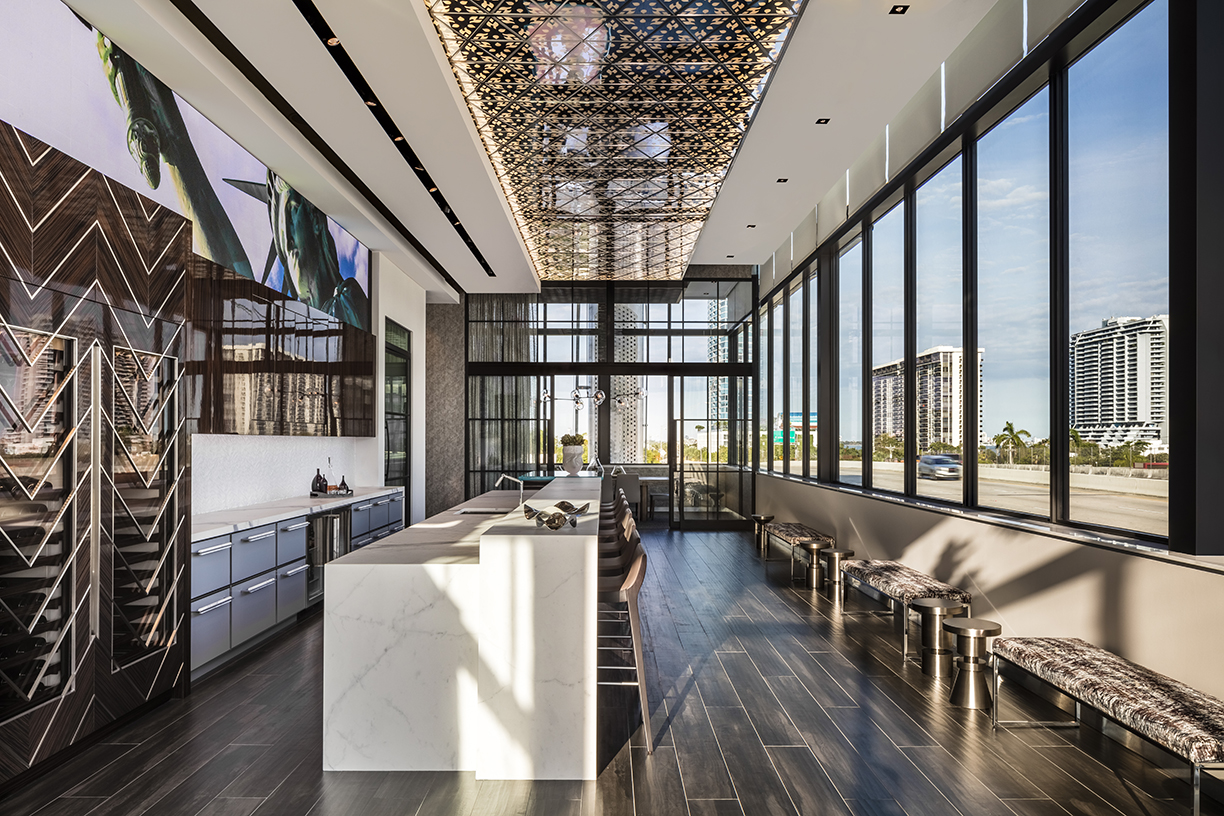
“We are so pleased to open our newest showroom in Miami, and to bring such a broad range of products to this important market. We chose the Miami Design District as the location because of the neighborhood’s commitment to supporting great design, architecture and culinary experiences,” said president and CEO of Sub-Zero Group, Inc. Jim Bakke. “We were able to imagine and build a space that allows us to welcome, educate and host groups and individuals who want to experience the quality and innovation of our products.”
A third-generation, family-owned company, Sub-Zero, Wolf, and Cove appliances have been continuously designed, tested and manufactured using premium grade materials in Madison, Wisconsin for more than 70 years. Developed with and for the design community, the products offer limitless design possibilities and are engineered to last more than 20 years. As a result, Sub-Zero, Wolf, and Cove products are widely known for superior craftsmanship, reliability and longevity. With the opening of the Miami showroom, the company now has 35 dedicated showrooms in the U.S. and 60 worldwide.
Photos courtesy of Sub-Zero Group, Inc.

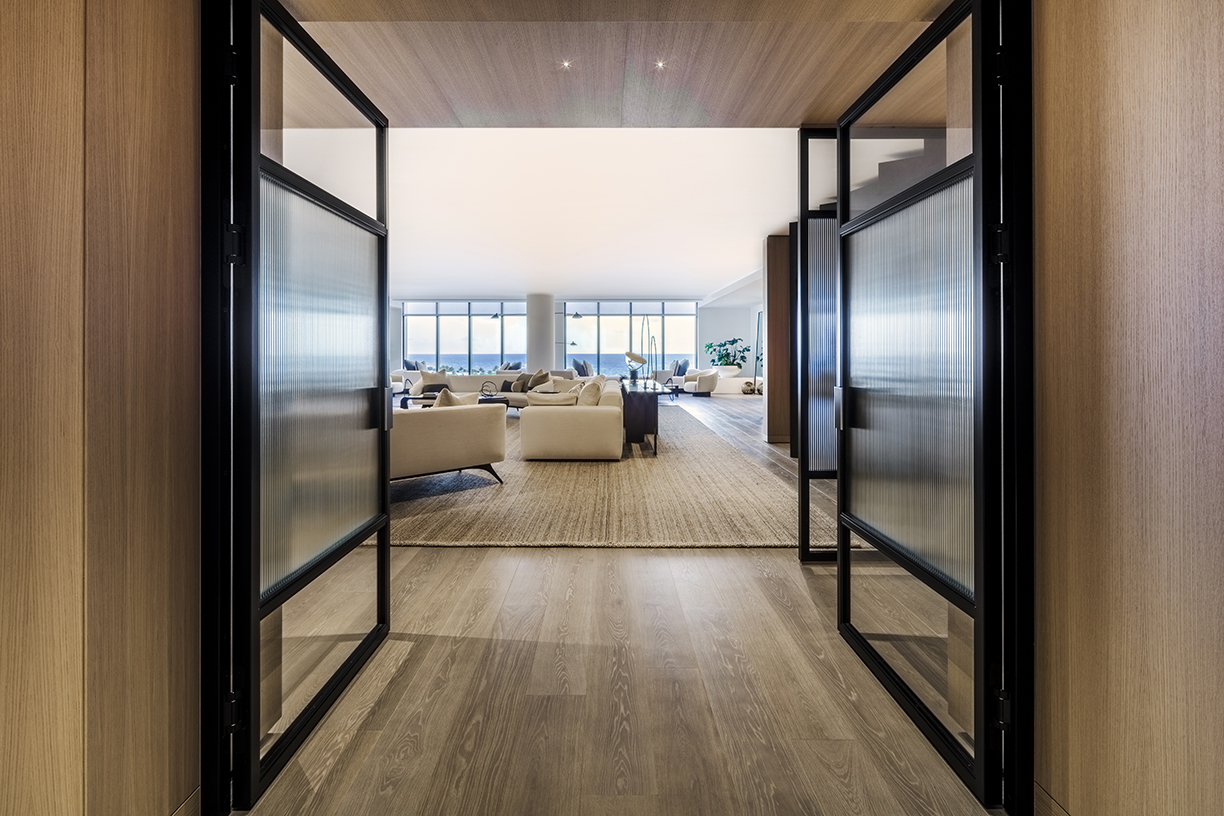
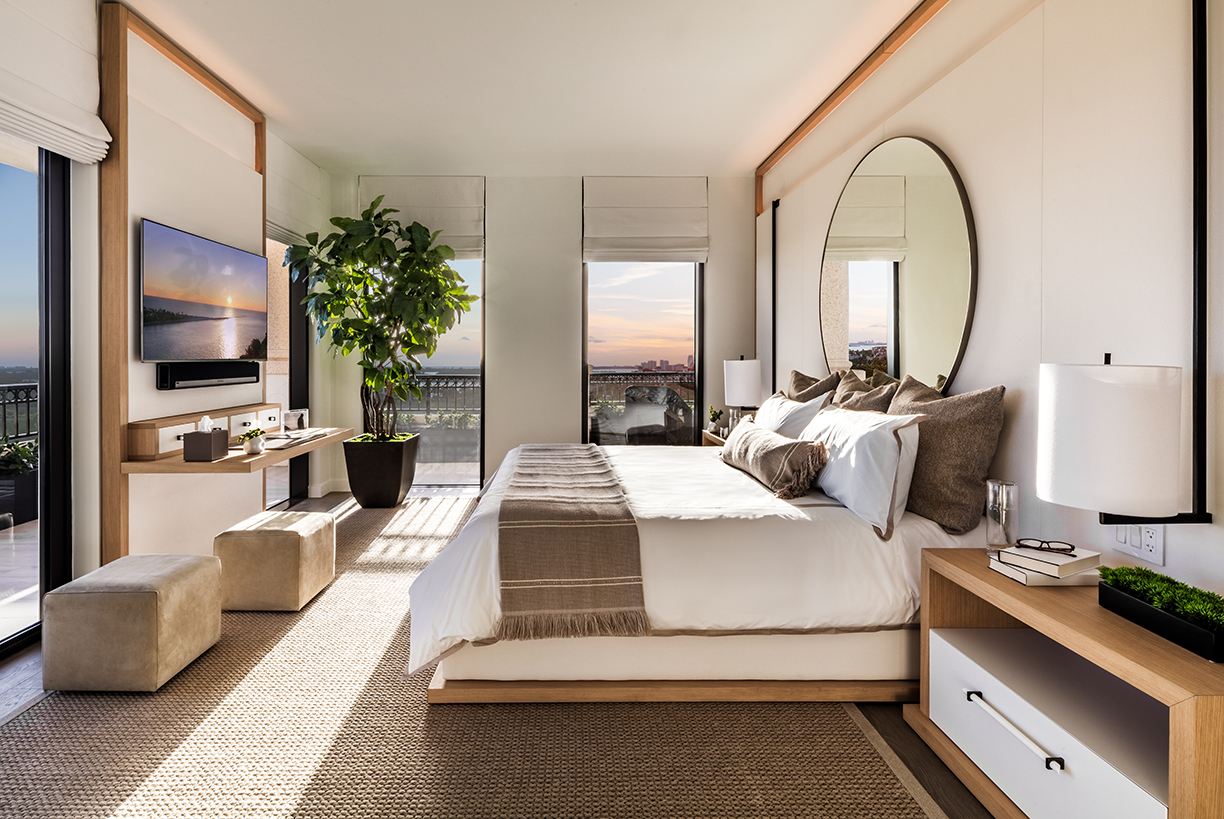
Inspired by its prime location and one-of-a-kind views, this 7,630-square-foot home on Miami Beach’s exclusive Fisher Island merges casual elegance with sophisticated design.
From the elegant, high-end furniture to the neutral color palette, interior designer Sam Robin meticulously crafted this residence at Palazzo Del Sol. We spoke with Robin to learn more about the inspiration behind this home’s unique design.
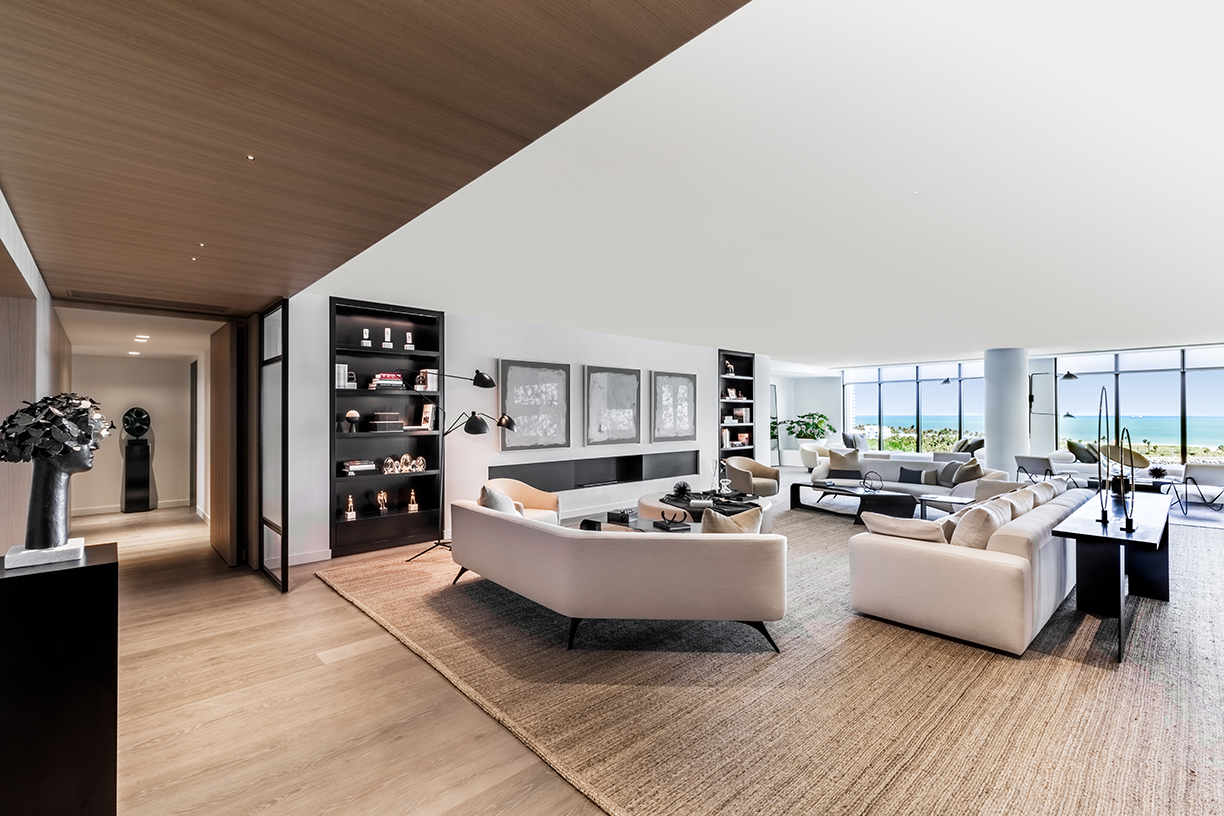
What are some of your favorite standout elements in this space?
The sweeping views of South Beach and Government Cut are absolutely breathtaking, and inspired me to enclose the elevator foyer into a gallery-like entrance. I wanted an intermediate between the building’s public spaces and the residence, and to create an element of surprise as the view is revealed.
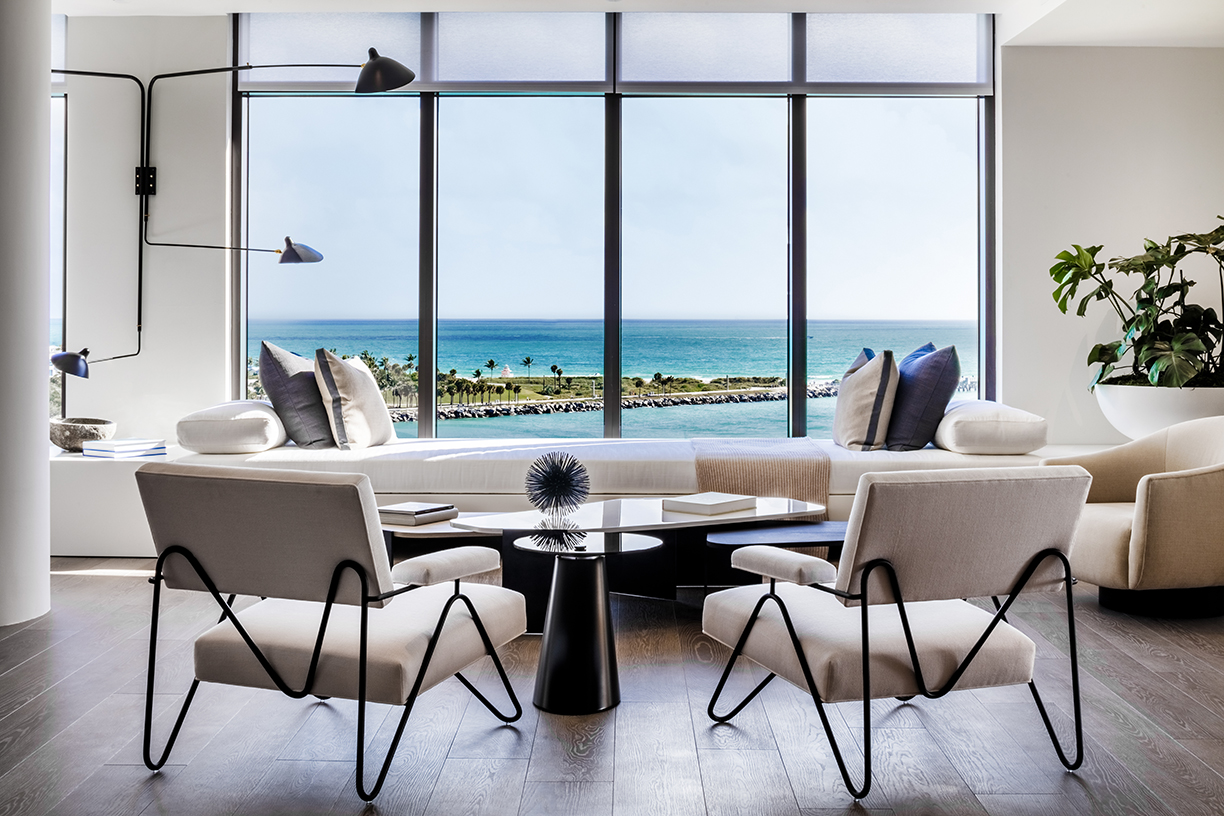
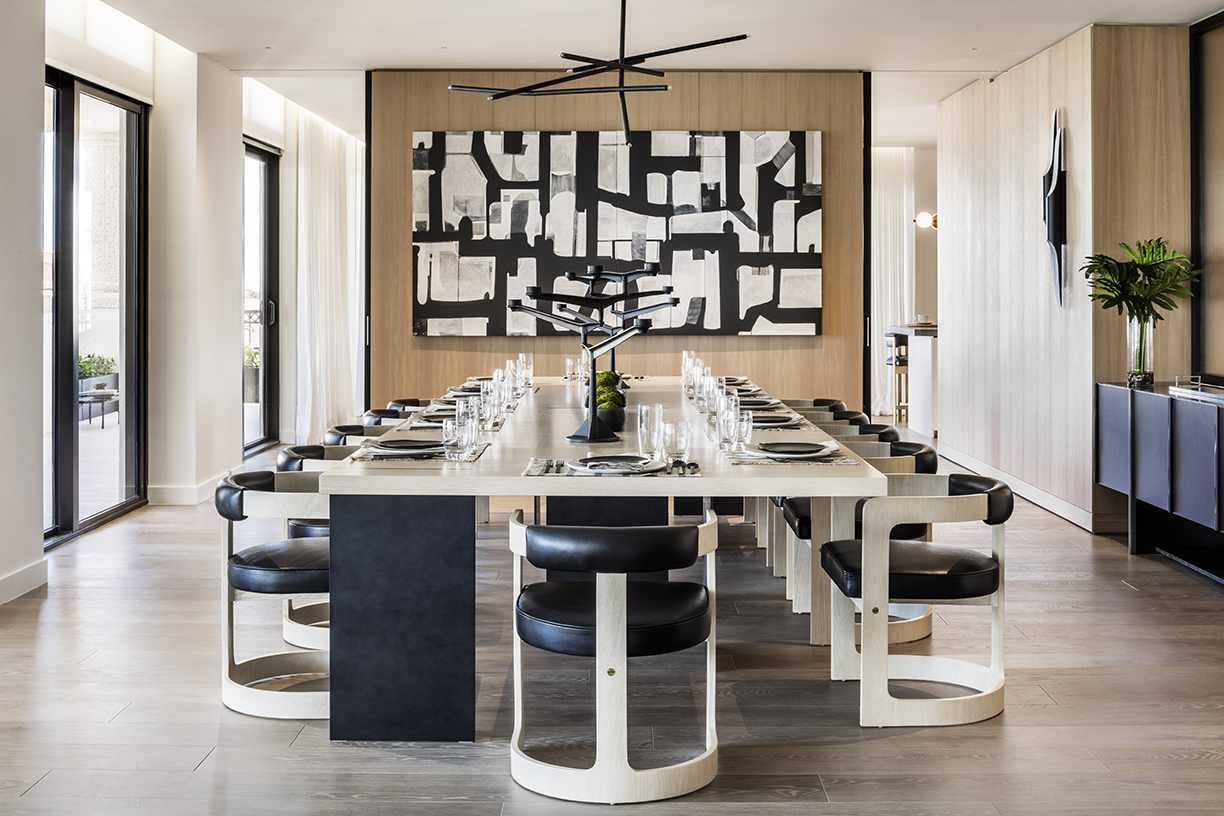
Who do you envision living here?
I pictured someone who is casually elegant and sophisticated who enjoys the beach and leisure of Fisher Island. The homeowner would more than likely host family and friends, so you’ll see several areas designed to accommodate and entertain groups.
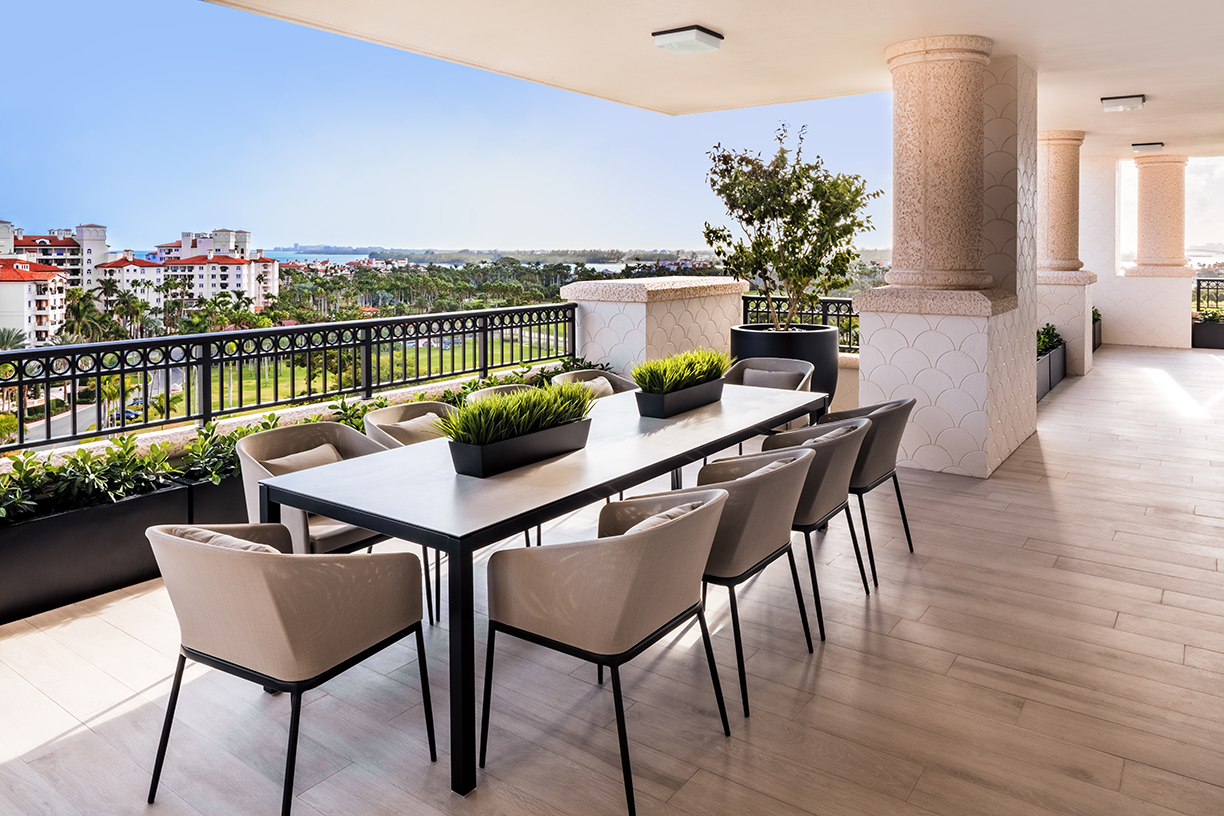
What mood were you hoping to have created in this space?
I stressed comfort, ease-of-care, family and entertaining. The homeowner should feel that they stepped into a space created specifically for them.
Why did you choose this color palette of the home?
The interior palette is light and neutral with contrasting hardware and details for an elegant yet relaxed aesthetic. I focused on creating a sophisticated space with clean lines that felt equally cozy and inviting. The neutral tones help to achieve that, and also help to maximize the views.
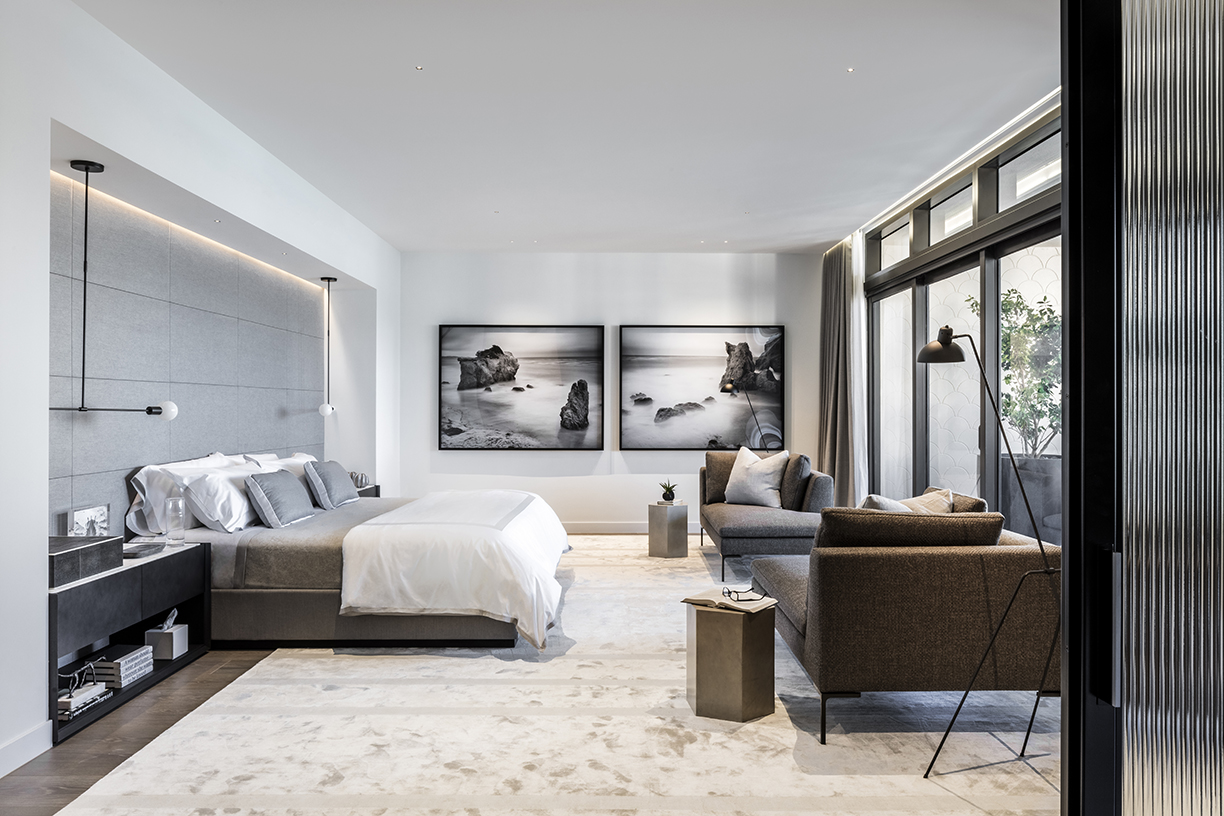
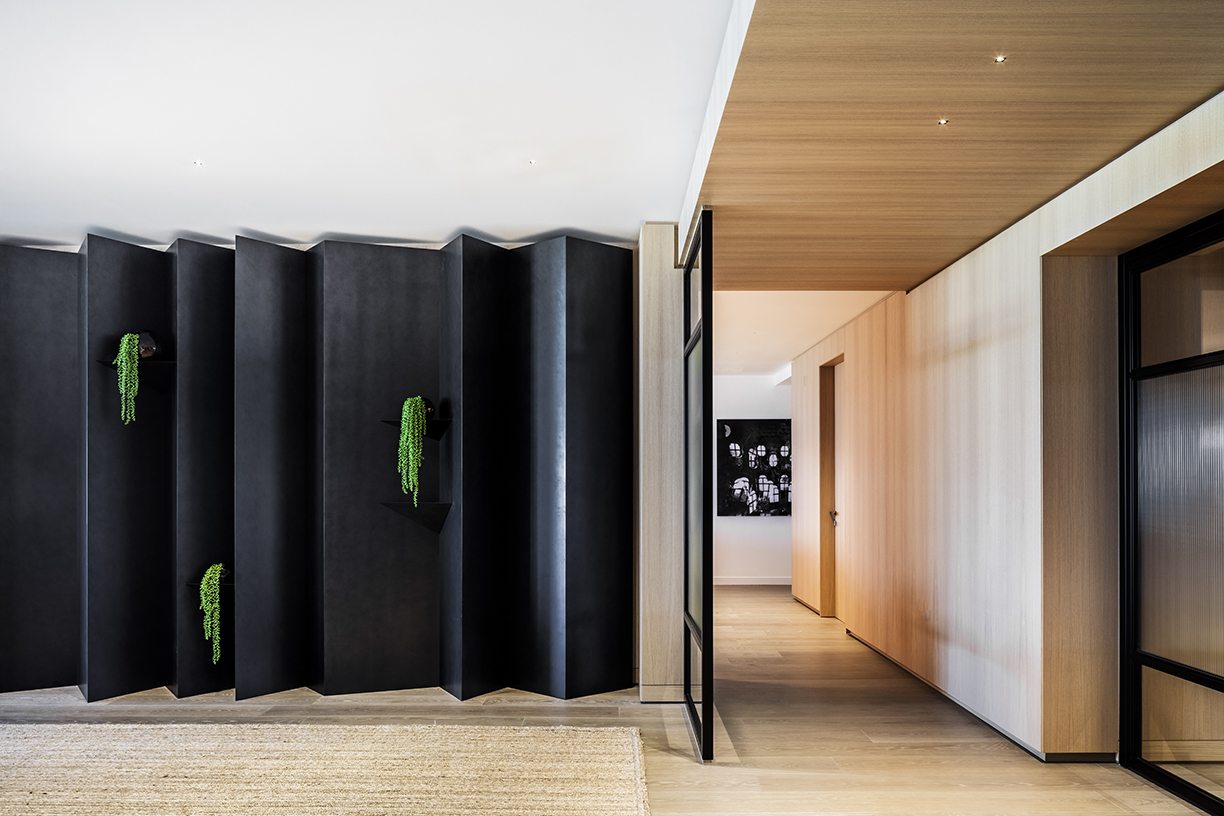
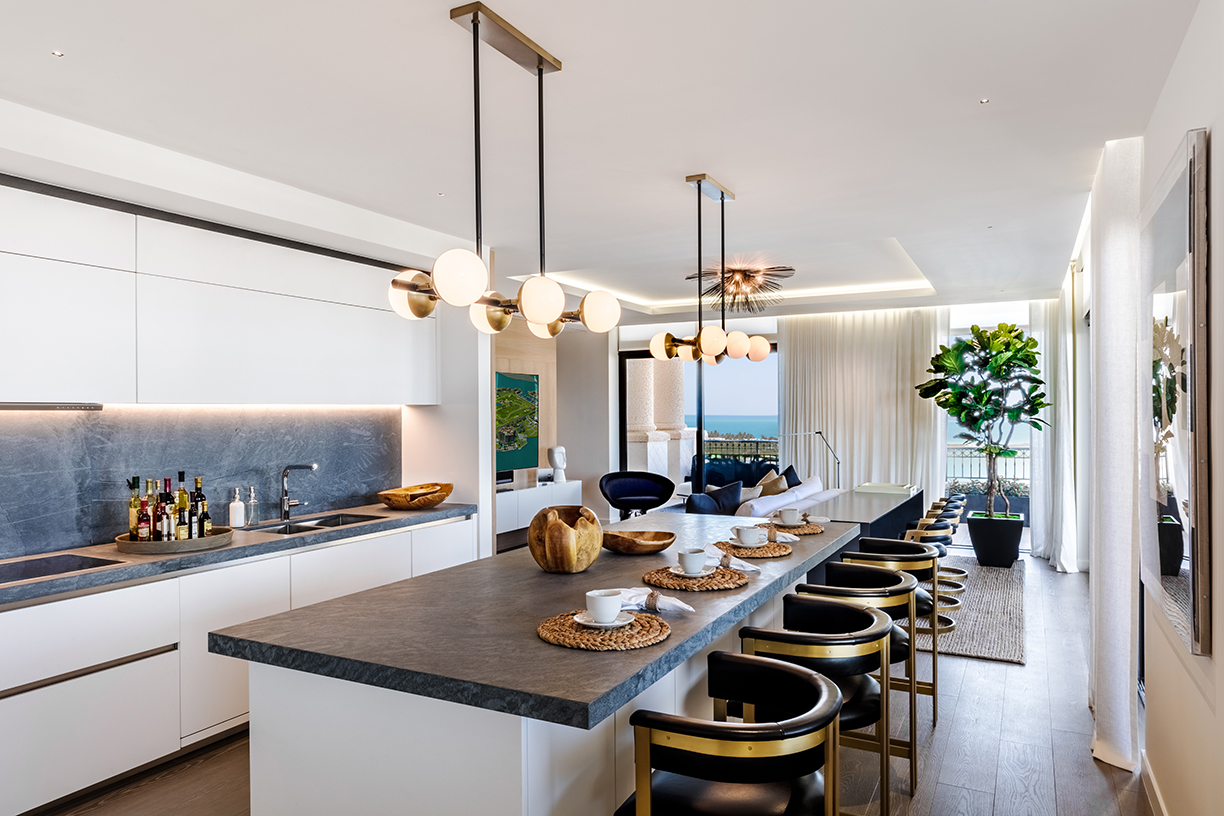
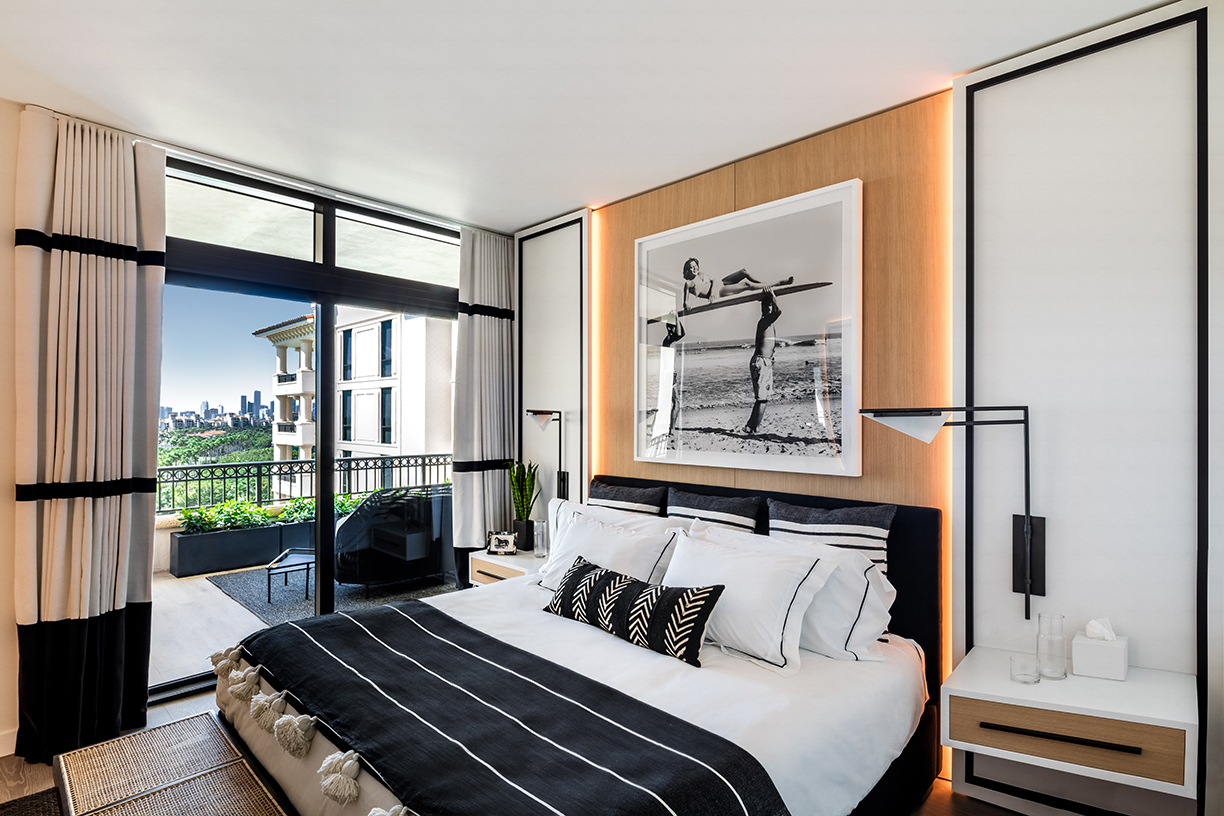
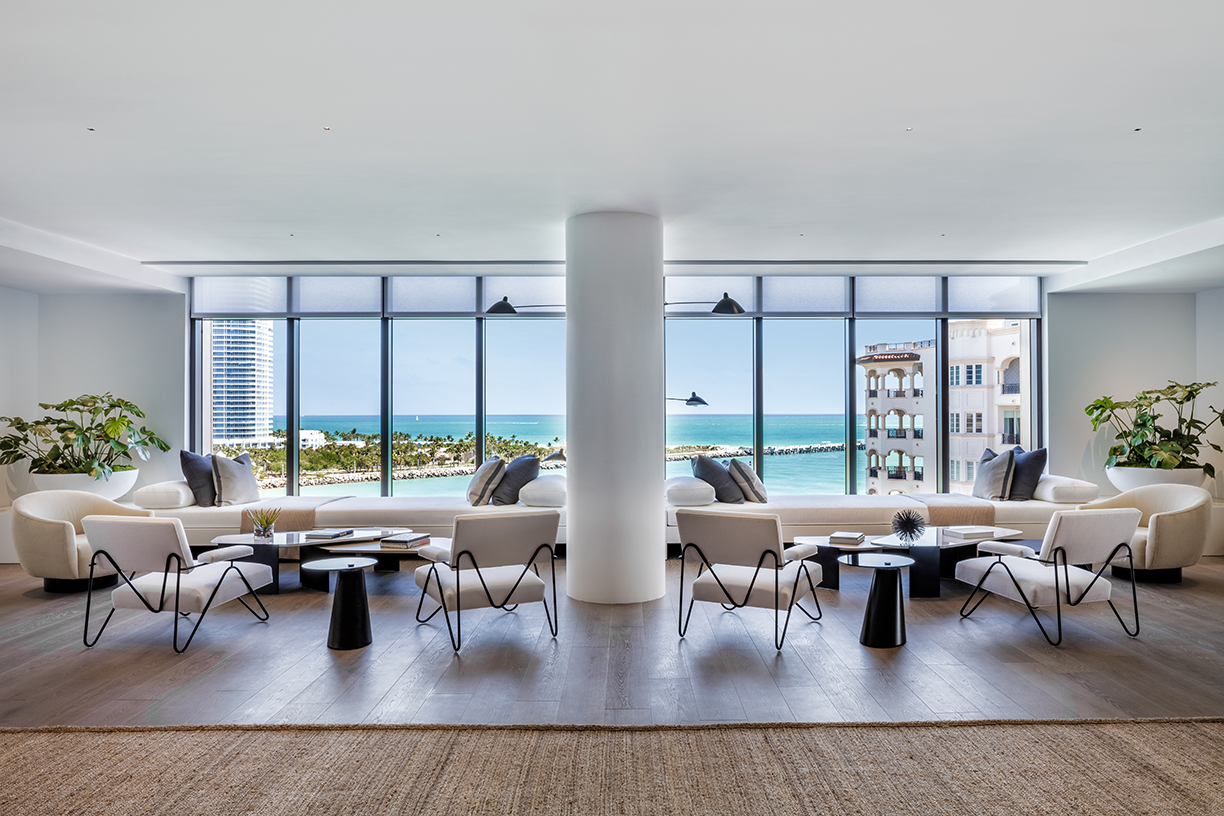
Were you able to bring any natural elements into the home?
In this space, I played on the surrounding environment and nature by incorporating wood in several ways. The walls and floors are covered in bleached white oak. The dining room features leather and cerused wood chairs around a bleached oak table. I also added greenery to the balconies and in corners of several rooms. It’s a subtle technique, but it’s effective in softening and pulling together large spaces.
Photos courtesy of Kris Tamburello
How did the ocean and city views influence your design?
The ocean inspired the overall ease of the home. When I think waterfront, I naturally go for a look that is less buttoned-up. The wraparound balcony and its oceanfront vistas bring natural light into the home, so we opted for a softer glow with lighting throughout.
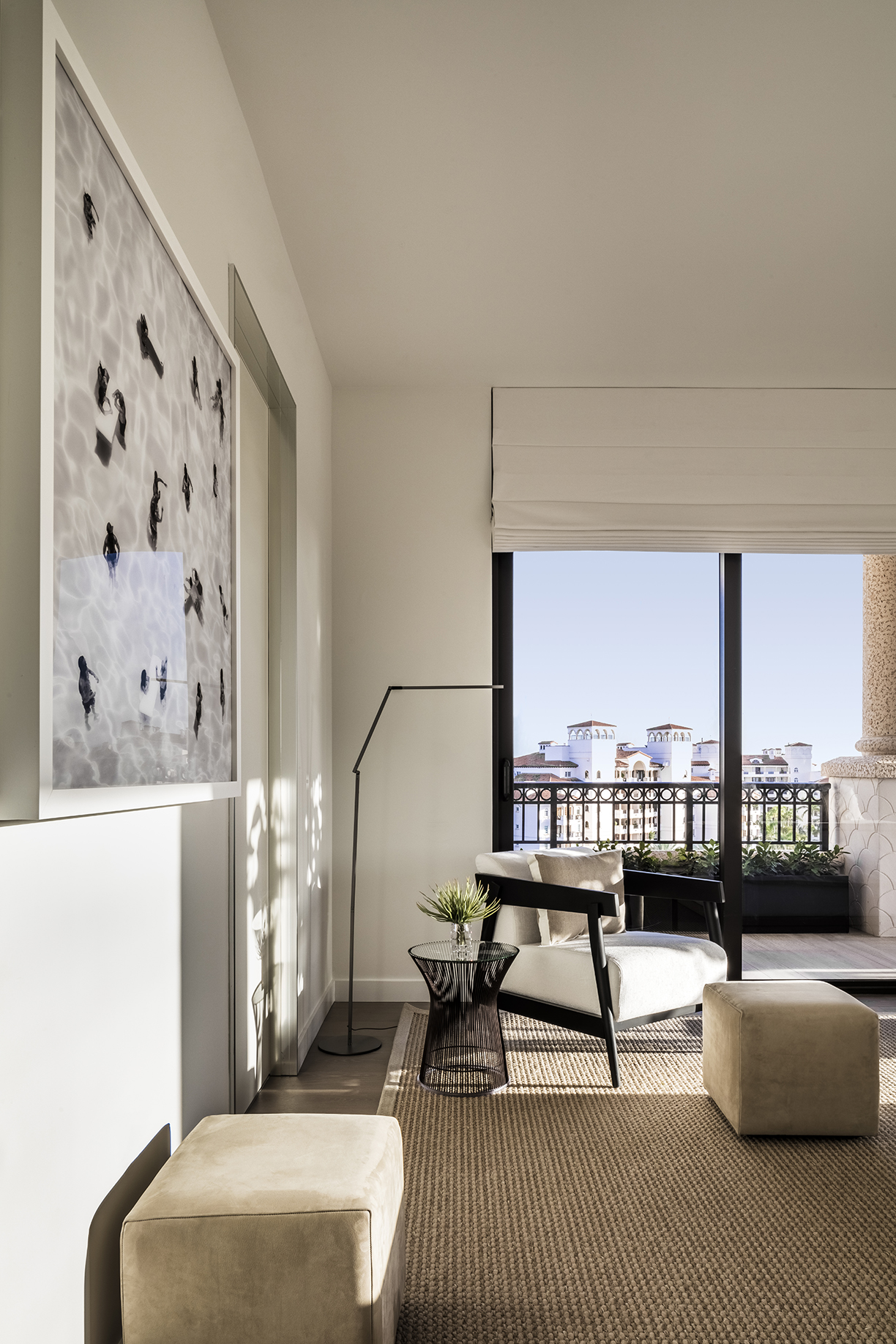
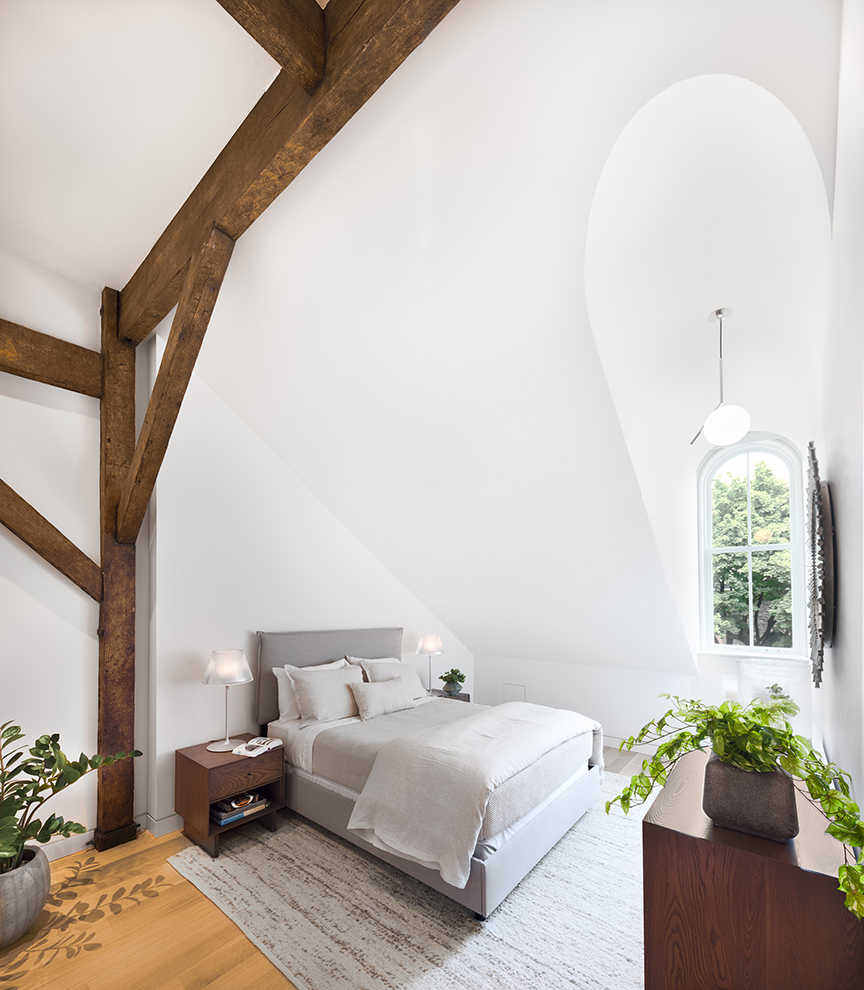
Residences at Prince Street. Photo courtesy Aaron Thompson.
Outfitting homes with an artistic ceiling creates a complete, dynamic space, often tying assorted aspects of home design together, from art to functioning space. In these examples, designers inspired to use interesting techniques have created complex designs that demand people to look up.
Gallery-Style Spaces
The character of a home is often shaped by the items inside it, including art or artistic detailing. Helping to define a home’s character, high ceilings within the home allow ample wall space for art lovers to adorn their walls with prized masterpieces. One example is seen in this Artefacto-designed residence in Bal Harbour, Florida, which boasts 10-foot-plus ceilings with customized panel backlights and recessed lights. The Oceana Bal Harbour unit also features floor-to-ceiling windows framing the breathtaking ocean and Intracoastal views.
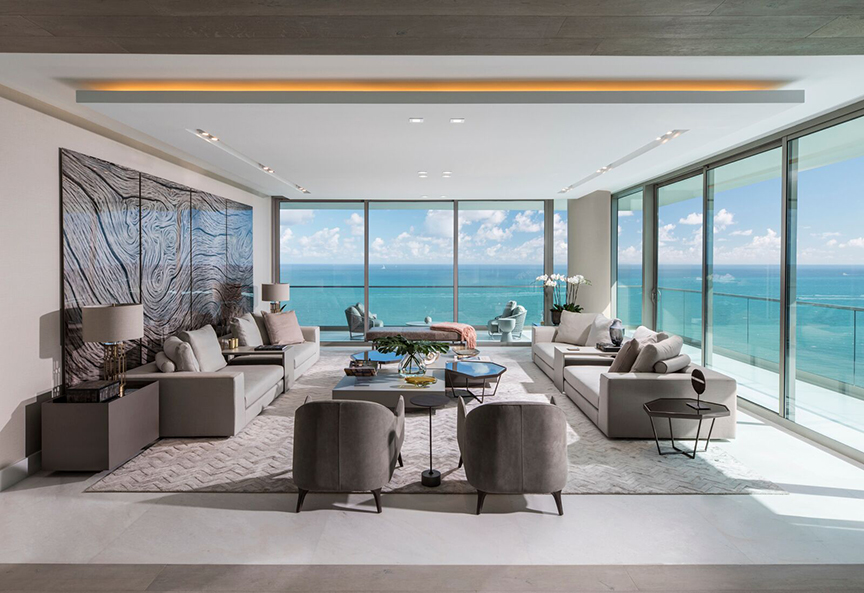
Photo courtesy Barry Grossman.
Embracing the Outdoors
A space can evoke different feelings depending on the environment, both inside and out. To embrace the elements, some spaces utilize the outdoors by bringing them in. Miami’s Brickell City Centre boasts a $30 million climate ribbon, a steel-and-glass elevated trellis that hovers over the retail center. An achievement in artistry and first of its kind, guests and residents of Reach and Rise can gaze at the sculptural element, as it protects them from inclement weather, captures sea breezes to regulate air flow and temperature, collects rainwater for reuse and allows them to enjoy natural light in an open-air environment.
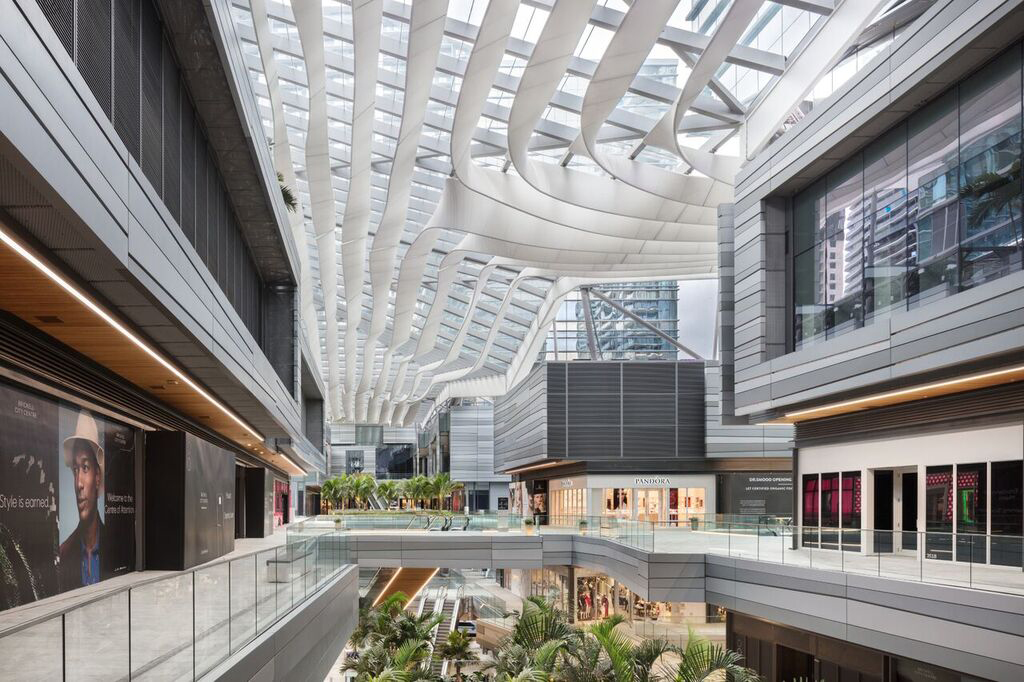
Photo courtesy Brickell City Center.
Smiling at the Past
Historical architecture is highly appreciated in the design industry, as it creates a traditional atmosphere for designers to either enhance or refresh with modern additions. These traditional styles of architecture extend into the home, seen through classic ceilings that add a unique element to the space. Residences at 62-66 North Third in North Williamsburg, New York, feature exposed, high concrete ceilings as a nod to the neighborhood’s industrial past. The residences embody a sense of character, design, and detail that combines modern and traditional Williamsburg in these expansive homes.
Another example with an authentic ceiling design is in this top-floor townhouse at the Residences at Prince Street, formerly part of St. Patrick’s Old Cathedral. The gabled ceilings with exposed wood beams reflect an authentically of the period; existing moldings and details were replicated throughout to create a top-floor living area with skylights and a cozy feel.
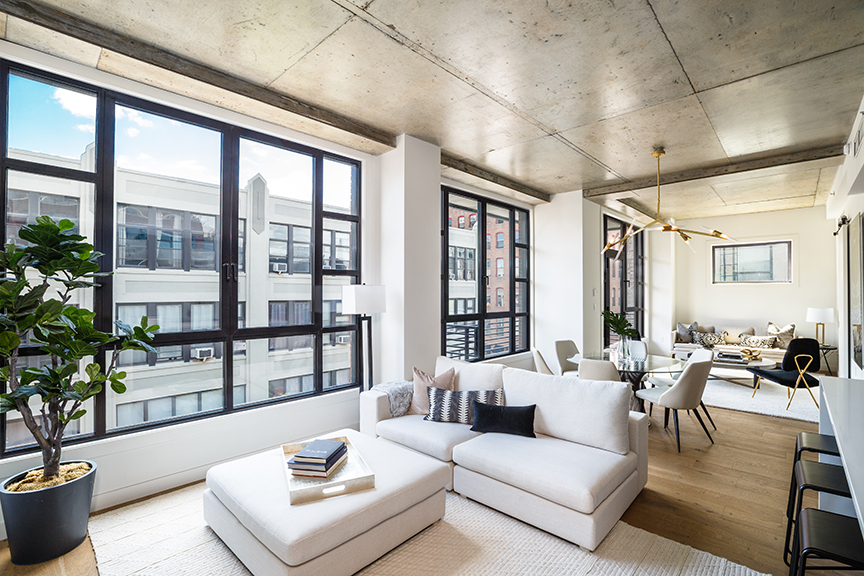
Photo courtesy MNS.














